GLOBALTO-LOCAL
Protecting populations and places
FALL 2019 #92 THE MAGAZINE OF PENN VET

LIFE IN THE 21ST CENTURY IS COMPLEX; THE CHALLENGES ARE SERIOUS AND VERY REAL.

DEAN ANDREW HOFFMAN



LIFE IN THE 21ST CENTURY IS COMPLEX; THE CHALLENGES ARE SERIOUS AND VERY REAL.

DEAN ANDREW HOFFMAN

Mark Spitzer, Chair of Penn Vet’s Board of Overseers, recently said the School is a “window on the future.” (See page 25.) I love this! It’s a hopeful message in an era when we are confronting new threats to food security, natural resources, and social justice in communities worldwide.
Mark’s words describe Penn Vet’s vital role in addressing many of these issues. At the nexus of education, clinical care, and research related to animals and humans, the School is perfectly positioned to create a healthier, more sustainable world for all earth’s inhabitants, from the smallest animals, such as invertebrates, to the largest, such as right whales.
This issue of Bellwether provides an overview of our work tackling complex issues with both local and global importance. Addressing Global Disease with Translational Science looks at faculty research on diseases of poverty, like hookworm, malaria, leishmaniasis, and schistosomiasis. In Speaking of Agriculture, I talk with Pennsylvania State Veterinarian Dr. Kevin Brightbill about our common interests and synergies in safeguarding agriculture. And Saving the Whales, One Orca at a Time profiles Dr. Joe Gaydos, V’94, who is taking an individualized approach to protecting marine wildlife populations in waters of the Pacific Northwest.
Each story profiles the critical role veterinarians and scientists play in our interconnected world and touches on a cross-section of my four priorities for Penn Vet: revolutionize veterinary career paths, ensure global health, foster agricultural sustainability, and maximize animal well-being and healthcare outcomes. Read more about the priorities on the next page and drop me a note — tell me what you think. Down the road, I look forward to sharing our progress and spotlighting the amazing people who help us chart the future of veterinary medicine.
Life in the 21st century is complex; the challenges are serious and very real. This is a call to action. For the School’s community of educators, practitioners, and scientists, our moment in time holds revolutionary promise to accelerate veterinary medicine’s impact on animal, human, and environmental health. We remain at the forefront of science and clinical care because of your commitment to Penn Vet. And I want to thank you for that support.
Dean Andrew Hoffman The Gilbert S. Kahn Dean of Veterinary MedicineWe will reimagine our curriculum to prepare current and future veterinarians for “practice-ready” careers, and for novel opportunities in public and human health.
We will reduce the burden of infectious disease and tropical disease in developing nations by accelerating scientific discovery into effective treatments.
We will bring Penn Vet’s wide range of agricultural resources to bear on the sustainability of food systems, from production to consumption to food waste management.
We will innovate access to primary care and optimize our extensive specialty care services to enrich the quality of life for all animals.
• For fall 2020, introduce a new curriculum for the 21st century
• Respond to societal needs through new “VMD-plus” dual degree programs
• Support entrepreneurial veterinarians
• Exploit our expertise in immunology, vaccinology, and host-pathogen interactions
• Facilitate research for the benefit of human medicine
• Support our faculty to push the frontiers of disease research
• Reimagine New Bolton Center’s conventional farm facilities into an integrated, sustainable model
• Invest in agricultural educational programming and brand building
• Grow student scholarships in agriculture
• Build a state-of-the-art facility for emergency and critical care at Ryan Hospital
• Establish a comprehensive body of patient-centered research
• Provide advocacy and effective instruction in animal welfare
To read more about Dean Hoffman’s priorities, go to www.vet.upenn.edu/our-priorities.
Take schistosomiasis, the research focus of Penn Vet’s Robert Greenberg.

“It’s not necessarily a death sentence, though there are fatalities,” says Greenberg, a research associate professor of pathobiology. “But you get anemia, children get stunted in terms of growth and cognitive abilities. It’s a disease that keeps people in poverty.”
Such diseases, by and large, receive less financial support and, as a result, far less scientific attention than those that more often afflict residents of wealthier nations, such as diabetes and heart disease.
Penn Vet researchers, however, have committed attention to these understudied diseases, which, taken as a whole, affect billions around the globe. Their work benefits from the niche strengths of the school, specifically in immunology and hostpathogen interactions.
“At the vet school, a third of our funding supports infectious disease research,” says Phillip Scott, vice dean for research and academic resources and a professor of microbiology and immunology in the school’s Department of Pathobiology. “That’s pretty amazing, given that the School is also awarded funding for regenerative medicine, for cancer, and for a variety of other areas.”
That strength, seen in the research portfolios of some of the more senior faculty, such as Christopher Hunter’s work on toxoplasmosis, James “Sparky” Lok’s studies of Strongyloides, Carolina Lopez’s investigations of lung infections, and Bruce Freedman and Ron Harty’s efforts against Ebola and other hemorrhagic viral diseases, is a factor that has attracted newer faculty members, like cryptosporidium expert Boris Striepen, to Penn Vet.
De’Broski Herbert, for example, an associate professor of pathobiology, held prior positions at Cincinnati Children’s Hospital and the University of California, San Francisco. He felt called to work on hookworm (pictured below), a parasite he first learned of growing up in the South from his greatgrandmother, who warned him about walking around barefoot because of the risk of contracting the parasite. But at the medical centers where he worked, he shifted gears away from studying the parasite itself, and instead focused on related research in asthma and allergy.
“Here, our veterinary students are likely to encounter parasites in their patients, so working directly on the parasite is easier to justify,” Herbert says.
This spring, Herbert traveled to Nigeria where, working with partners at the Nigerian Institute of Medical Research, he launched a study of hookworm in 300 school-aged children in five sites around the northern and central portions of the country.
“The goal is to first establish what the prevalence of the disease really is and draw attention to that,” Herbert says. “And secondly, this is a place where the World Health Organization is going in and doing mass treatments, so I’m also interested in learning something very novel about the association between the microbiome, tissue repair, immune suppression, and metabolism in these children in Nigeria.”
Most people don’t die from neglected tropical diseases like hookworm, schistosomiasis, or even malaria. But these diseases, often caused by parasites, rob them of health in sometimes insidious ways.
NIGERIA
“AT THE VET SCHOOL, A THIRD OF OUR FUNDING SUPPORTS INFECTIOUS DISEASE RESEARCH.”
DR. PHILLIP SCOTT Vice Dean for Research and Academic Resources
Those insights could lead to treatments, but they will also likely shed new light on the basic science of how hookworms affect their host. This pairing of basic and applied work is characteristic of Penn Vet scientists. In Scott’s lab, for instance, which has long pursued studies of the tropical disease leishmaniasis (pictured above), advances in basic science have unfurled alongside insights that stand to reshape treatment of this parasitic infection which, in its cutaneous form, can cause serious and chronic skin ulcers.
“When I was a postdoc at NIH, there’s something my boss used to say that I still use in my talks,” says Scott. “He said, ‘Leishmaniasis has done more for immunology than immunology has done for leishmaniasis.’ And you could substitute parasitology for leishmaniasis and it would be much the same quote.
“What I think is exciting right now,” he adds, “is that that’s going to change.”
As part of this contribution toward advancements against parasitic disease, Scott has traveled regularly to a leishmaniasis clinic in Brazil to obtain samples for his research, and, back at Penn, has paired up with dermatology and microbiome experts such as Elizabeth Grice in the Perelman School of Medicine, and Dan Beiting from Penn Vet’s Center for Host-Microbial Interactions, to break new ground.
No vaccine exists for leishmaniasis and current therapies fail a substantial percentage of the time. But recent publications out of Scott’s lab have revealed new information about how the disease and existing treatments work, and when to predict when they don’t. At the same time, Scott and colleagues’ research into the immunology of the infection has identified ways that FDA-approved drugs could be leveraged to alleviate the most severe forms of leishmaniasis.

A major hurdle to matching appropriate therapies with neglected disease comes at one of the earliest stages of medical intervention: diagnostics. Researchers at Penn Vet are employing innovative techniques to fill these unmet needs. Robert Greenberg is one who has crossed disciplinary boundaries to do so.
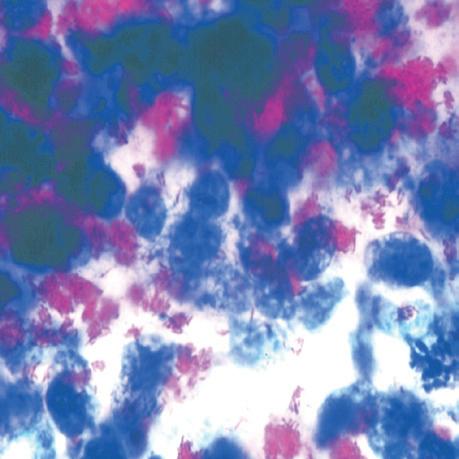
In a partnership between Greenberg and Haim Bau of Penn’s School of Engineering and Applied Science, the scientists are working to craft an improved diagnostic test for schistosomes, the water-borne, snail-transmitted parasites which can lead to anemia, tissue fibrosis and lesions, malnutrition, learning difficulties, and, depending on the parasite species, also bladder cancer and heightened HIV risk.
Greenberg has studied the ion channels that govern key biological functions in schistosomes to potentially develop drug targets that paralyze and kill the organisms. And by adapting insights from other researchers about additional parasitic-specific targets, he’s helping Bau train his microfluidic, portable diagnostic system on schistosomes to one day help clinicians make point-of-care diagnoses and issue timely treatment for infected patients.
“The current diagnostics are pretty terrible,” Greenberg says. “We’re looking at some new approaches now that should give us a much earlier, more sensitive, and more specific diagnosis for individual patients and that might be able to detect other co-infections simultaneously.”
At New Bolton Center, Marie-Eve Fecteau and Ray Sweeney are also taking part in the design of a 21st-century solution to diagnostics of an insidious and challenging disease—in this case, a disease that takes a particular toll on livestock: paratuberculosis, otherwise known as Johne’s disease. Caused by a bacterium Mycobacterium avium paratuberculosis, (pictured right) the condition affects ruminants such as cows and goats and drastically decreases their weight and milk production.
“Ruminants are a very important part of survival and livelihood in developing countries,” says Fecteau, an associate professor of food animal medicine and surgery. “Families may rely on only one or two cows to provide for their nutritional needs or income, and if that cow is affected by Johne’s, that’s a serious problem.”
Paratuberculosis has been shown to be endemic in parts of India and elsewhere in Asia, and is also a burden for U.S. farms, where 70 percent of dairy herds test positive for the infection. Separating infected animals from the herd is a key step to stem the spread, but the bacteria has proved difficult to grow in the lab, making diagnosis challenging.
Fecteau and Sweeney, the Mark Whittier & Lila Griswold Allam Professor at Penn Vet, are hoping to change that, working with Beiting and biotechnology firm Biomeme to develop a “lab in a fanny pack,” as they call it: a stall-side diagnostic test that relies on polymerase chain reaction (PCR) to identify infected animals from stool samples within hours.
“This is the kind of technology that could be extremely valuable for use in areas where sophisticated technology is harder to come by,” says Sweeney.
Elsewhere at Penn, researchers are approaching globally significant diseases by focusing on the vector. In the insectary that is part of Michael Povelones’s lab, he and his team test methods to stop disease transmission cycles within the mosquitoes (pictured right) themselves.
In the work, which relies on disrupting the way that mosquitoes interact with or respond immunologically to the pathogens they pass on, Povelones, an assistant professor of pathobiology, has explored everything from dengue to Zika to heartworm to elephantiasis—and his discoveries have implications for targeting a much longer list of diseases. In a recent study, Povelones and colleagues developed a new model system for studying the transmission of diseases caused by kinetoplastids, a group of parasites that includes the causative agents of Chagas disease and leishmaniasis.
“We think this could be a model for a number of important neglected diseases,” Povelones says.
In the latest of his team’s work finding ways to activate mosquitoes’ immune system to prevent pathogen transmission, they’ve identified a strategy that both blocks heartworm and the parasite that causes elephantiasis.

“These two diseases have very different behavior once they’re in the mosquito, so we’re still figuring out why this seems to work for both,” says Povelones. “But we’re very encouraged that it does.”
Using these types of creative approaches is a common thread across the School, and their efforts and successes seem to be multiplying. To continue accelerating progress, the school is developing a plan to harness these strengths, working with existing entities such as the Center for Host-Microbial Interactions internally and cross-School units such as the Institute for Immunology.
“We are a key part of the biomedical community at Penn, and bring a valuable veterinary component to the table in confronting diseases of poverty,” says Scott.
 DR. PHILLIP SCOTT Vice Dean for Research and Academic Resources
DR. PHILLIP SCOTT Vice Dean for Research and Academic Resources
“WE ARE A KEY PART OF THE BIOMEDICAL COMMUNITY AT PENN, AND BRING A VALUABLE VETERINARY COMPONENT TO THE TABLE IN CONFRONTING DISEASES OF POVERTY.”
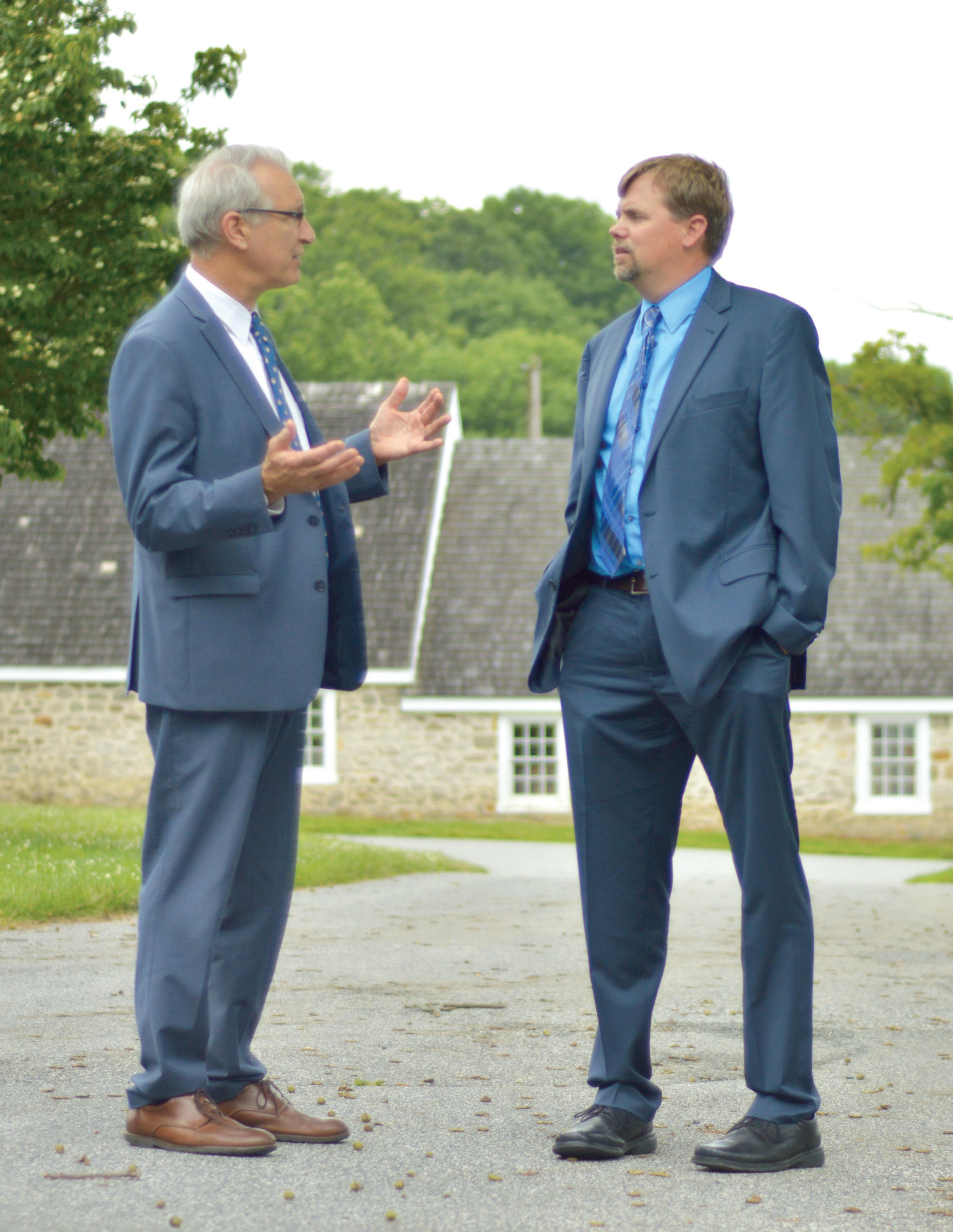
Agriculture is one of the leading drivers of our nation’s economic system. In Pennsylvania, the industry has a massive footprint, contributing nearly $136 billion to the state’s economy and employing one out of every ten residents. Approximately 59,000 farms, the majority of them family-owned, across all counties in the Commonwealth grow and harvest food.
Penn Vet is a valuable partner to the industry, specifically to the Pennsylvania Department of Agriculture (PDA). The School’s New Bolton Center offers clinical field service, and herd health research and management for dairy, poultry, and swine animals through the Center for Animal Health and Productivity, and diagnostics for the agricultural community through the Pennsylvania Animal Diagnostic Laboratory System (PADLS).
Given these synergies, it’s natural that Dean Andrew Hoffman and State Veterinarian Dr. Kevin Brightbill have a lot to say about agriculture. In June, the two met at New Bolton Center for a lively discussion of threats to food safety and security, disease prevention and management, and the future of the veterinary profession. This is a condensed version of their conversation.

Hoffman: As the dean of the state’s only veterinary school, I’m looking from a 50,000-foot view at what threatens the sustainability of our agricultural system. I’m always considering, as an institution, how we can deploy our resources to help farmers optimize food production, profits, and sustainability from the perspective of ecological impact. And importantly, we need to promote — and adhere to — the ethical treatment of animals. Improving industry standards, particularly as it relates to how animals live and work, is part of our veterinary oath and mission. For example, a large consumer population is outspoken against poultry and swine practices. We need to be responsive to these concerns. Otherwise, this will have a significant impact on the perception and success of agriculture in Pennsylvania.
I also worry about biosecurity. It is a constant threat, locally, regionally, and globally. We’re continually watching for pests or diseases that can harm livestock, poultry, and equine operations.
Brightbill: On the ground, my department closely monitors outbreaks of diseases: the highly contagious virulent Newcastle disease has been a problem for backyard birds in California for more than a year. African swine fever is circulating across the globe — it’s not a matter of if it will reach the U.S., it’s a matter of when. Avian influenza is out there. And chronic wasting disease (CWD)1 is an emerging threat that’s devastating for captive and free-ranging deer.
Hoffman: Wildlife is critical. Wildlife can be carriers of disease without exhibiting any clinical signs, requiring innovative forms of surveillance. Throughout history, things like avian influenza have had a wildlife reservoir. Lately, we’ve seen an outbreak of coryza in the poultry industry, and, while suspected, we don’t know if wildlife are a reservoir for this disease.
We always have to safeguard agricultural systems from endemic infectious diseases, like rabies. Agriculturerelated infectious bacterial diseases, such as salmonella, are increasingly a problem. Just look at the increasing number of human salmonella cases from backyard chickens. Bugs like E. coli are becoming resistant to antibiotics, making antibiotic usage a big issue in agriculture programs and policies.
Brightbill: A big one. A lot of diseases are becoming an issue in Pennsylvania because of weather changes and global warming — like the rise of the East Asian or longhorned tick that’s showing up and bringing more cases of tick-borne diseases.
Hoffman: Right, right. And, of course, other hallmarks of climate change can affect animals and agriculture. If we don’t have clean water, if we’re wasting energy, we’re undermining sustainability of farming, eating into profits and livelihoods.
Brightbill: Whatever the threat, we need to look ahead and be proactive.
Brightbill: Being prepared is like a military operation. We need protocols and people with a really good understanding of how disease spreads and animals are moved around. And we need strong public/private partnerships. Land grant, private institutions, and regulatory agencies must work cooperatively to protect the food supply and ensure sustainability. CWD, for one, is progressing, and we are at a critical point where we need consensus and cooperation across different bodies.
Misinformation is frequently a problem. As educators and researchers, Penn Vet has a tremendous role in objectively correcting misinformation, as do PDA and private practitioners. In general, stakeholders — the public, veterinarians, farmers, policymakers, and agencies — need evidence-based information on threats like CWD.
Hoffman: In many areas, Penn Vet and PDA have the same stakeholders. To be proactive, we absolutely must have a shared set of priorities. Kevin brings a very sharp, fresh set of ideas and perspectives to the PDA that closely align with Penn Vet’s.
He’s right that Penn Vet offers a unique, objective perspective — we are not regulators or an advocacy organization but a neutral third party with research and data to support our positions.

The issues are complicated. Identifying problems and collaborating to solve them better positions everyone to directly address rising threats. For example, we need to work together to innovate solutions to the Spotted Lanternfly invasion.
Brightbill: The PADLS2 is a great example of where the School and state come together. It shows how a creative public/private partnership can work well to protect agriculture.
Hoffman: I’ll start with wildlife. There’s no real surveillance of wildlife health in Pennsylvania. But we’re beginning to understand many vectors — flies, mosquitoes, and ticks — cause problems in wildlife populations. The problems can escalate pretty quickly, and we need a wildlife health system. The Pennsylvania Game Commission (PGC) has funded a new program at Penn Vet called the Pennsylvania Wildlife
Futures Program. Launched in August, the program is developing a surveillance infrastructure to help mitigate infectious diseases, starting with CWD, that could impact any of Pennsylvania’s 480 species of birds and mammals, including agriculture animals and humans.
Brightbill: Whether we’re talking about safeguarding wildlife, livestock health, food supply, or human health, an integral part of the conversation is traceability of animals and food sources. PDA is trying to move forward radio frequency identification technology to track an animal’s movements. With disease, knowing where an animal was, where it is, and where it’s going is vital.
We are also exploring blockchain3 technology for tracking food. Having a barcode or a QR code that links back to a food item’s point of origination not only helps track disease, it also drives value back to farms by giving consumers visibility into who is growing and making food they love.
Hoffman: There’s a clinical care component to consider. We envision a partnership with the PDA to establish a large animal healthcare system that links large animal veterinarians across the state for support and information exchange.
It’s also time to pilot telemedicine and point-of-care diagnostics. Penn Vet is pioneering the latter. A group in the School’s Center for Host-Microbial Interactions has developed on-site DNA or RNA sequencing of material from dead or dying animals. It will enable veterinarians to know right away what they’re dealing with and completely revolutionize veterinary care for livestock, poultry, equine, and aquaculture. And I’m excited about a new project the U.S. Department of Agriculture will fund. Our Working Dog Center will train dogs to detect Spotted Lanternfly eggs, the cryptic stage of the organism. The invasive insect is hurting the grape, timber, and other industries. Once the dogs are trained, we can explore with the PDA how we might deploy them throughout the Commonwealth.
Taking another step toward sustainability, Penn Vet is investigating the potential of a scalable, carbon neutral farm that integrates our dairy, swine, and equine facilities with respect to waste and water management, and energy generation. We aim to show sustainable farming can be productive and profitable on our New Bolton Center footprint — we have 160 milking cows, by the way, and thus are the largest dairy operation at any vet school in the country.
“Whether we’re talking about safeguarding wildlife, livestock health, food supply, or human health, an integral part of the conversation is traceability of animals and food sources.”
DR. KEVIN BRIGHTBILL
Hoffman: Consumers are among our greatest stakeholders, and a majority of consumers are in Pennsylvania’s cities.4 Urban dwellers buy and eat livestock, poultry, fish, and produce, so agriculture very much matters to them. At the same time, farmers are informed by consumer trends and interests. It’s a symbiotic relationship. We need to link farmers to consumers on a larger, more influential scale.
Brightbill: Farms feed people everywhere, which is all the more reason for traceability. People want to know where their food comes from. If an animal isn’t traceable, the consumer can be wary, regardless of where he or she lives.
Hoffman: We’ve talked about some overwhelming concerns, but, on a bright note, everywhere I’ve been where there are dedicated, informed veterinarians, there are healthy agriculture communities. The two go hand-in-hand. Veterinarians support farmers — they provide clinical care, education, and moral and intellectual support, making a real difference in the sustainability of a farm.
Our role as a veterinary school is to train all students and develop our faculty to lead in issues we’ve discussed. Penn Vet is stepping into these areas with new degree programs and a new core curriculum.
Brightbill: It all goes back to being proactive. Veterinarians need to constantly retrain and retool. Graduating students must embrace and be able to market consulting skills, whether in biosecurity, nutrition, or appropriate animal husbandry techniques.

Veterinarians are really sentinels. We’re more likely to see a disease pop up in livestock or in people’s pets before it hits humans. And veterinary training and education must support this reality.
Hoffman: This brings me to Penn Vet students. We train students to be watchful sages, to be critical thinkers and lifelong learners who effect change and drive sustainability.
1 CWD is a fatal neurodegenerative disease in the family of prion diseases or transmissible spongiform encephalopathies. There’s no known treatment and the disease has been found in captive and free-range deer in Pennsylvania.
2 PADLS is a partnership among Penn Vet, PDA, and Penn State University that provides rapid and accurate veterinary diagnostic services to protect animal health, human health, food safety, and the economic well-being of Pennsylvania.
3 More about blockchain: www.farmanddairy.com/news/will-blockchain-play-role-in-agriculture/512126.html and www.agriculture.pa.gov/Documents/ PennsylvaniaAgriculture_EconomicImpactFutureTrends.pdf
4 According to the U.S. Department of Health and Human Services’ Rural Information Hub, only 1.4 million of Pennsylvania’s 12.8 million residents live in rural communities.
“This brings me to Penn Vet students. We train students to be watchful sages, to be critical thinkers and lifelong learners who effect change and drive sustainability.”
DEAN ANDREW HOFFMAN
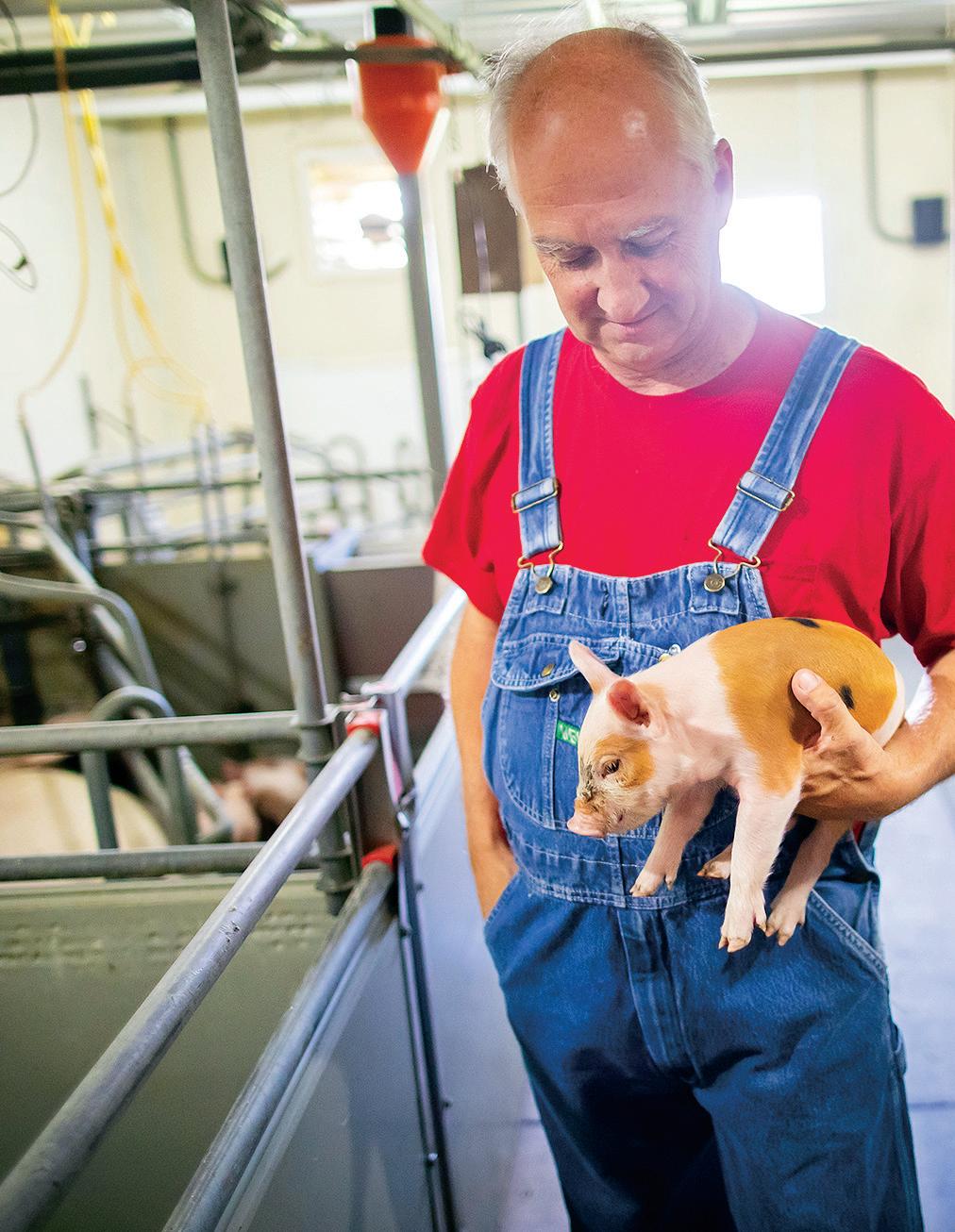 BY GINA VITALE
BY GINA VITALE
Parsons and his colleagues have spent years crafting and refining their swine unit at Penn with the aim of making pig farms more sustainable nationwide. Their “farm of the future,” with humane conditions and efficient use of resources, stands to reshape the environmental and social impacts of raising swine.

The way Parsons sees it, to define a pig farm as sustainable, it must be both socially acceptable and economically viable.
“For most farmers, farming is not a livelihood, it’s a lifestyle,” Parsons said. “And so if they lose that social license, not only do they lose their livelihood, but they lose their lifestyle.”

Eliminating gestation stalls is one of the primary ways the swine unit has worked to introduce more socially acceptable practices. Previously, it was also standard industry practice for sows to be kept in small stalls—some so tiny that the pigs weren’t able to turn around—so that they could be fed without competing with one another for food. At New Bolton Center’s facility, sows instead have RFID chips implanted in their ears. When they walk into the food dispenser, their chips are scanned, and a pre-measured meal is released.
Such improvements, along with purchasing high-quality organic food and providing more room for each animal, can come with considerable expense, especially on large farms. At the Swine Center, Parsons aims to create a model farm that remains cost-competitive even when scaled up. Part of that balance is determining whether or not farmers will be able to charge more for their sustainably raised meat to offset the higher costs of production.
“We’ve got the next generation becoming decision makers in terms of buying food,” Parsons said. “They’re asking the question where their food comes from, and in some cases, not always liking the answers. And so I think that’s where we’re at — we’re in this transition.”
DR. THOMAS PARSONSAt Penn Vet’s Swine Unit at New Bolton Center, 500-pound pigs squeal and strut in a sunny outdoor pen. Dr. Thomas Parsons, director of Penn Vet’s Swine Teaching and Research Center and professor of swine production medicine, pats their sides as they sniff at his denim overalls.
“For most farmers, farming is not a livelihood, it’s a lifestyle, and so if they lose that social license, not only do they lose their livelihood, but they lose their lifestyle.”
Millennials, Parsons adds, are starting to spend more of their disposable income on sustainably raised products, even though they have less to spend than older generations.
Penn Vet’s model farm also considers environmental sustainability in its operations. Solar panels have been installed to help run the facility, and according to the research team, many other pig barns also have south-facing roof space where solar panels could be effective at harvesting energy. The farm has also become certified organic, which means that the pigs receive their nutrients from entirely organic feed.
The Swine Center’s farming research is starting to have real impacts on the nearby community. According to Parsons, around 60 percent of the sows raised in Pennsylvania are no longer confined to gestation stalls, more than any state besides the three that ban the practice. Many of those farms, Parsons said, are also looking to minimize their use of antibiotics.
Bob Ruth of Clemens Food Group is one such producer who has benefited from the expertise of Penn Vet researchers. Ruth has worked with Parsons and Dr. Gary Althouse, associate dean of sustainable agriculture and veterinary practices, for decades to innovate and modernize his company’s large-scale operations.
“It’s a great relationship,” Ruth said. He has invited vet students to visit and work on research projects involving the company’s farms, and in turn receives guidance and professional connections that have put him at the leading edge of the industry.
“Working with Penn Vet, we are continuing to innovate and adopt practices that allow us to deliver more freedom to our animals in a modern pig-producing farm. We feel very fortunate to be connected with people like Tom and Gary.”
To keep firms like Ruth’s at the forefront of innovation, while ensuring overall sustainability, the Swine Center is

“From an agricultural standpoint, resources are finite. How are those resources best utilized for the growth that we’re expecting when you look at 10 years, 20 years, 50 years?”
DR. GARY ALTHOUSEworking to anticipate how the need for different resources will fluctuate and change in the coming decades.
“From an agricultural standpoint, resources are finite,” said Althouse. “How are those resources best utilized for the growth that we’re expecting when you look at 10 years, 20 years, 50 years?”
Althouse aims to help educate the next generation of veterinarians, as well as the public, about the importance of sustainable agriculture.
“What I’m excited about here at Penn Vet is to be able to better formalize, ‘What is sustainability?’” he said. “Being able to address it beyond just looking at an organism or looking at an animal, but looking holistically, and providing that training to our veterinary students, as well as through our outreach to better sustainability of agriculture.”

 BY SACHA ADORNO
BY SACHA ADORNO
What do killer whales off the U.S. Pacific coast and wild mountain gorillas in Central Africa have in common? On the surface, not much. But digging a little deeper, members of each group exhibit unique, identifying characteristics and endearing personalities. They are part of complex, tightly knit family structures. And both populations are at risk.
“When it comes to protecting these species, the approach is comparable,” said Dr. Joe Gaydos, V’94. “Veterinary intervention is helping save mountain gorillas from extinction, and now we’re applying similar tactics to saving whales.”
Gaydos is senior wildlife veterinarian and science director at the SeaDoc Society, a UC Davis research and education nonprofit that ensures the health of marine wildlife in the Pacific Northwest’s Salish Sea.

The number of whales in these waters is lower than ever before — “currently at 73 animals,” Gaydos said. At the same time, thousands of miles away, the highland mountain gorilla population, once on the critically endangered list, is experiencing a promising rebound after years of veterinary care for sick and injured members.
For decades, wildlife veterinarians have monitored the health of single gorillas, much like medical doctors do human patients. Tracking gorillas at a discrete level provides opportunities to reduce threats to the larger group, like deforestation, dwindling food sources, and the overall health of gorilla trackers and their families.
“The gorilla program started with things like removing snares, and evolved into a One Health initiative,” explained Gaydos. He visited Rwanda to learn about the work of Gorilla Doctors, a UC Davis field program and “sister” to SeaDoc. “As veterinarians, we have to be both reactive and proactive. We help individual animals to strengthen entire species.”
It’s a strategy SeaDoc and partner organizations believe can work for whale pods in the Salish Sea. They’re creating a shareable database of medical records for each whale, following the animals’ health over time.
This effort is happening in the body of water Gaydos calls a “sea of superlatives.”
The Salish Sea spans Puget Sound, the San Juan Islands, and waters off Vancouver, British Columbia. Home to 172 bird species, 253 fish species, and more than 3,000 species of invertebrates, it’s one of the world’s largest and most biologically rich inland seas.
Although, according to Gaydos, even with such incredible marine life diversity, everyone really, really loves the whales. Among the 37 mammal species in the sea are “three ecotypes of killer whales— one eats salmon, one specializes in sharks, and one strictly eats marine mammals. People travel from all over to see them.”
Today, the Penn Vet alumnus spends many days among the Salish Sea’s creatures — either swimming with them or watching from the water’s surface — a world away from where he launched his veterinary career in Philadelphia.
“My passion has always been the outdoors — camping, fishing, hunting, wildlife,” he said. “When it came time to choose between a rural vet school and Penn Vet, I thought it wouldn’t bode well for me
“ALL THE COOL THINGS I’VE EVER DONE IN MY LIFE, I’VE BEEN TERRIFIED OF. BUT I HAVE A REALLY STRONG FOUNDATION FROM PENN VET. THE SCHOOL TRAINS THINKERS MORE THAN TECHNICIANS, AND THIS HAS SERVED MY WORK WELL.”
DR. JOE GAYDOS, V’94
to be outside all the time. I was better off in an urban area, where I’d hunker down and study.”
In Philadelphia, Gaydos enjoyed proximity to Philadelphia’s unique offerings, like the Philadelphia Zoo. “I did an externship at the Zoo, where I had great exposure to wildlife without having to travel,” he said. And post-graduation, through a Zoo connection, he worked in Zimbabwe with “lions and black rhinos and cheetahs... it was awesome!”
After Africa, Gaydos went into mixed practice in West Virginia before earning a PhD in medical microbiology.
“Just as I finished my degree, I saw a listing for the SeaDoc position,” he recalled. “I didn’t have any marine wildlife experience but applied anyway.” They hired him. (Gaydos’s learning curve was so steep, he had “so many questions,” at one point a colleague asked if he was in the witness protection program.)
“All the cool things I’ve ever done in my life, I’ve been terrified of,” he said. “But I have a really strong foundation from Penn Vet. The School trains thinkers more than technicians, and this has served my work well.”
SeaDoc’s work is hard. Though teeming with wildlife, the Salish Sea is under threat. Years of overfishing, shipping, and toxic waste have disrupted the delicate ecosystem, leading to some heartbreak.
In 2018, Gaydos and his colleagues mourned the loss of J50 — aka Scarlet — a four-year-old Orca and SeaDoc patient. Over the summer, Scarlet started losing weight. Diagnostic tests were limited, but non-specific. Gaydos and others suspected the bacteria was stressing the whale’s immune system, keeping it from fighting whatever was making her sick. For two months, they tried administering antibiotics through salmon and dart gun. But despite intense medical intervention, Scarlet failed to thrive and was last seen a year ago. She is presumed dead.


“We get discouraged,” said Gaydos. “I try to celebrate the small successes.”
Successes like new policies for hunting scoters. Over the past 25 years, the marine bird’s populations dropped by 50 percent. SeaDoc research found hunting in the area was unsustainable, a conundrum in a geography where the practice supports 6,800 jobs annually.
As a result of SeaDoc’s study, the Washington Department of Fish and Wildlife enacted a policy dramatically curtailing hunting and made a plan to completely stop all harvest if the scoter population falls below 55,000 birds — a win/win/win for birds, hunters, and SeaDoc.
As for the whales, it’s too early to tell what the future holds. “The gorillas took decades to rebound,” said Gaydos. “But if we never try — if we don’t keep at it — we may never get to that point with the whales. A few decades from now, we hope to look back and celebrate large-scale success for the Salish Sea, whales and all.”


During the past year, Penn President Amy Gutmann has traveled across the U.S. and internationally to present the Knowledge for Good panel series. Part of the University’s $4.1 billion The Power of Penn: Advancing Knowledge for Good campaign, the event features distinguished Penn faculty from different schools in conversation with President Gutmann about the University’s plans to grow inclusion, spark innovation, and accelerate impact around the world. Penn Vet took the stage in two events.
More than 300 alumni, parents, and friends attended the San Francisco Campaign Kickoff Celebration for The Power of Penn: Advancing Knowledge for Good. Penn Vet’s Dr. Nicola Mason, Paul A. James and Charles A. Gilmore Endowed Chair Professor, shared a panel with Amy Hillier, Associate Professor, School of Social Policy and Practice, and Jamal J. Elias, Walter H. Annenberg Professor in the Humanities, Penn Arts and Sciences.
For an audience of more than 400, Penn Vet’s Dr. David Galligan, Marilyn M. Simpson Endowed Chair Professorship in Large Animal Clinical Studies, participated in a panel with Winka Dubbeldam, Miller Professor and Chair of Architecture, Weitzman School of Design, and Karl T. Ulrich, Vice Dean of Entrepreneurship and Innovation and CIBC Professor; Professor of Operations, Information and Decisions at The Wharton School.
Galligan spoke about his work to improve the health and productivity of animals in the dairy and agricultural industries while limiting damage to the environment.
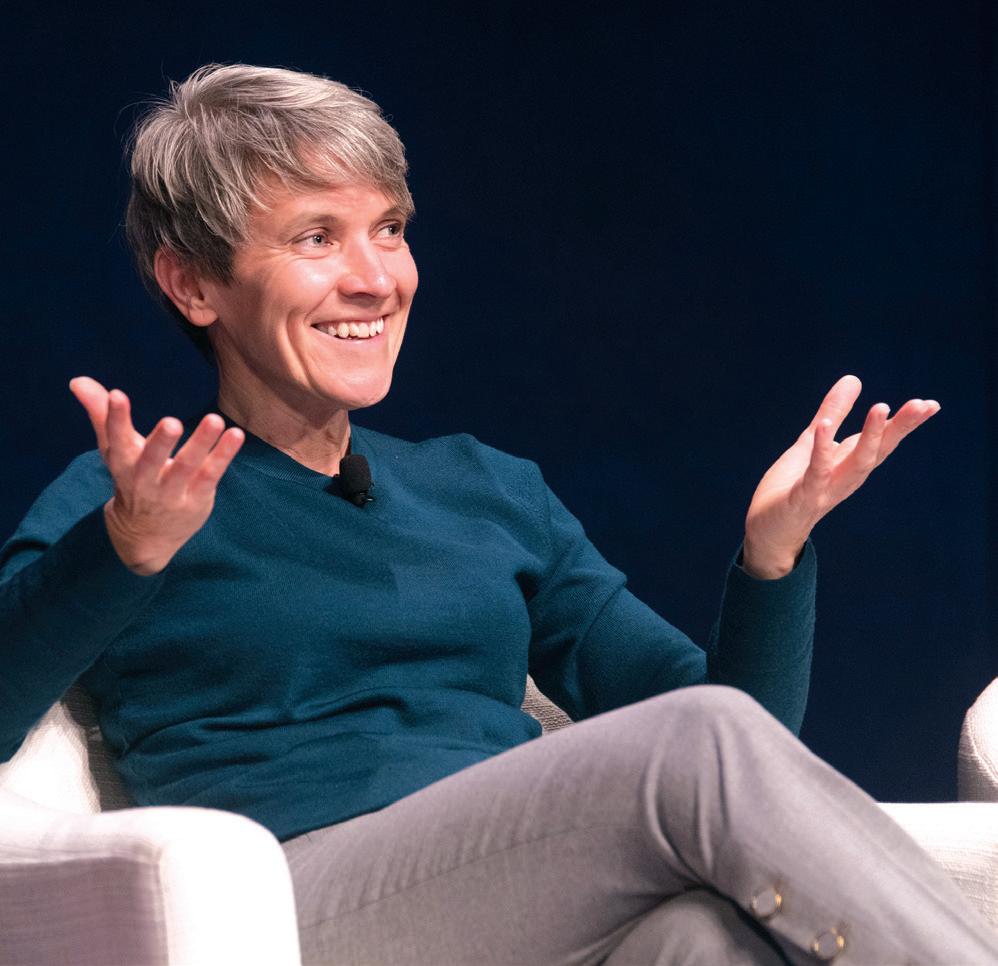

Together at a recent meeting, Ian Penkala, ENG ’13, VMD-PhD ’21, and Mark D. Spitzer, W ’71, had the easy affinity of longtime friends. In reality, the two Penn alumni met only recently in a partnership of sorts. Through his participation in The Power of Penn Vet Campaign, Spitzer, Chair of Penn Vet’s Board of Overseers, supports the Tracy and Mark Spitzer Endowed Scholarship Fund for research-oriented graduate students. Penkala is the scholarship’s first recipient.

“Education was very important to my parents. They grew up in New York City during the Great Depression and left high school to work,” said Spitzer, co-founder and principal of the Clinton Companies, a holding company engaged in real estate investment. “I received scholarships and low interest loans to attend Penn. Now it’s my turn — I’m privileged to be able to give back and support intelligent, curious Penn Vet students interested in scientific discovery.”
Research, specifically the School’s VMD-PhD program, is what drew Penkala to Penn Vet. “I worked in a Penn Vet lab as a chemical engineering undergrad,” Penkala said. “The experience inspired me to be a veterinarian and study here. No other school offers the rigorous combination of biomedical research and clinical teaching.”
A member of the pulmonary-focused Morrisey Lab and collaborator with the Frank Lab, both at Perelman School of Medicine, Penkala studies alveoli, air sacs in the lung that exchange oxygen and carbon dioxide with the bloodstream. He’s interested in their role in respiratory diseases.
He referenced his recent discovery about hyperoxic lung injury (HLI) in mice, which mimics the type of injuries premature babies face when overexposed to oxygen. “Researchers don’t understand why the lung is injured, what cell types are injured,”
he explained. “I found this one particular cell type is very plastic in the neonatal period and affects how the lung regenerates following injury.”
The persistent injury results in a less rich surface area for the gas exchange as the animal ages. Adult mice that once had HLI seem fine, but when they exercise, they don’t succeed like their litter mates who were never exposed to hyperoxia.
“It’s somewhat of a model we see in clinics with kids who were preemies. They appear healthy as they age but then can’t play sports in high school or overexert themselves, and we’re trying to figure out why,” said Penkala. “So, this cellular plasticity, in particular of this one cell type, is a unique view of why this disease is persistent. I’m investigating signaling mechanisms on how it happens.”
“Ian is going to make a difference; studies like his can have a direct translational application to premature babies,” said Spitzer.
Spitzer has served on the Board of Overseers since 2012 and now heads it with Vice Chair Martin E. Winter, G’76, W’76. “This is an exciting time for Penn Vet,” said Spitzer, who is working with the School’s leadership to determine additional avenues for his philanthropy. “I joined as former Dean Joan Hendricks led the School through a serious threat of state budget cuts. She persevered and put us on a visionary One Health track. Today, the School is fiscally strong and has a dynamic dean in Andrew Hoffman. We’re a real window on the future, focused on where science and medicine need to go.”
Spitzer’s philanthropy is catapulting Penn Vet into the future. Scholarship gifts like his enable talented students like Penkala to pursue clinically focused research careers and solve pressing health challenges.
“Mark’s support made coming to Penn Vet possible for me — it would have been financially unfeasible otherwise,” said Penkala. “I’m using my graduate school stipend to pay off my undergrad loans. Without this opportunity, I might have worked in an engineering firm and not become involved in research at all. Mark’s generosity has completely changed the course of my life.”
A lasting collaboration between Freedman (seated) and Harty is giving rise to promising compounds for targeting Ebola. The pair’s company, Intervir, is now working to refine inhibitor molecules they hope will prove effective at quelling Ebola infections in animal models— and one day, humans.

Ebola just isn’t going away. Following the major 2014 outbreak in West Africa, the deadly infection came back with a vengeance last year in the Democratic Republic of Congo, where the death toll recently reached 2,000. Since long before the earlier outbreak raised Americans’ consciousness about the disease, researchers Ronald Harty and Bruce Freedman of the School of Veterinary Medicine had been collaborating with other scientists to find drugs to dispatch the infection.
Like many viruses, Ebola can mutate quickly, potentially evading the reach of some targeted therapies. The disease can also claim lives in short order. Those who don’t survive their infection can die within days. And while a vaccine for the virus exists, it’s not widely distributed. For these reasons, Harty and Freedman and colleagues have aimed their scientific investigations at developing an inhibitor compound that interferes with the interaction between the virus and host it’s attempting to overwhelm.
A virus such as Ebola spreads by hijacking a host cell’s machinery, as it lacks its own equipment to carry out tasks critical to its ability to reproduce. Blocking the virus’s ability to
interact with host proteins is a strategy to limit infection. For Harty and Freedman, a specific target has been blocking budding, a process by which the virus slips out of a host cell after replicating itself inside.
“The idea behind the host approach is, not only should it work against quickly evolving strains of the virus, because these interacting domains are critical to the viruses’ life cycle,” says Freedman, “but also viruses often use similar mechanisms to interact with the host. So, much like using a broad-spectrum antibiotic to treat a bacterial infection, by using a drug that targets the host-viral interaction you may be able to block a half dozen or more different pathogens that could be using those same mechanisms.”
At Penn Vet, researchers use a variety of laboratory tests that don’t involve the actual viruses to screen compounds that might block budding and slow down viral spread. The first assay uses virus-like particles, or VLPs, which mimic the budding process. The second examines the protein-protein interaction between the specific elements of viral and host proteins involved in budding. And the third uses a nonlethal virus, vesicular stomatitis virus, to test the effectiveness of the viral inhibitors the team is screening.
“If all three of those look good,” says Harty, “then we know we have a good candidate to test with authentic Ebola virus.”
For those more-involved experiments, the Penn Vet team partners with colleagues at the U.S. Army Medical Research Institute of Infectious Disease, which has a Biosafety Level 4 laboratory.
Already, those tests have generated solid data, and now Harty and Freedman are working with colleagues within the Fox Chase Chemical Diversity Center to improve upon the viral inhibitors they’ve identified.
“We’re seeing good results with Ebola but also with related hemorrhagic fever viruses like Marburg and Lassa fever,” says Harty. “The next big step, and that’s what we’re working on now, is to try to tweak one of these inhibitors so we can use it in an animal model to see if it works there.”
Based on the promise of their findings to date, Harty and Freedman have launched a company, Intervir, to help refine and bring these inhibitors to market.
“The hope is that a therapeutic could be given to an individual who is positive for Ebola virus, to block the transmission or spread in that person or to dampen that spread and allow that person’s immune system more time to fight the virus,” says Harty. He likens such a drug to Tamiflu, which lessens the impact of the influenza in vulnerable individuals.
“We’re following the science,” adds Freedman, “and we’re learning a lot along the way. If we wind up with a drug that can help people, that will be something we’ll take to our graves as a life’s accomplishment.”
In an experiment by Harty and Freedman, virus-like particles of Ebola (in green and yellow), which mimic the process by which the authentic Ebola virus spreads, exit a cell along filaments of actin (in red), a structural protein. Harty and Freedman are designing compounds to block this process, increasing the likelihood an infected individual could recover.
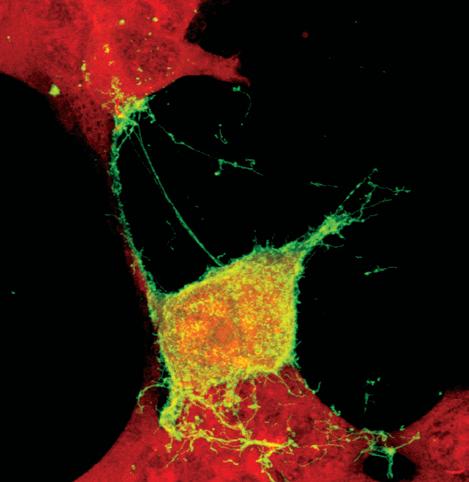

“We’re seeing good results with Ebola but also with related hemorrhagic fever viruses like Marburg and Lassa fever. The next big step, and that’s what we’re working on now, is to try to tweak one of these inhibitors so we can use it in an animal model to see if it works there.”
RONALD HARTY
On sunny days, light floods the glass-walled López Lab, catching on plants, people, and benches and benches of equipment. Less visible, even in the brightest sunlight, are the many nanoscopic viruses at the center of the lab’s work. But they’re there, growing in vitro by the millions.
Led by Dr. Carolina López, Associate Professor of Microbiology and Immunology, the López Lab studies the interplay between viruses and the immune system that protects us from infections. López has identified defective viral genomes that are generated during the standard virus replication process, and she is especially interested in the role these agents play in viral infections.
It’s an area of study she didn’t foresee early in her career. “I trained in biochemistry and immunology,” she said. “While an undergrad, I studied contact dermatitis to urushiol, the compound in poison ivy that causes allergic reactions. I became intrigued by viruses and their resourcefulness. In grad school, I joined an antiviral immunology lab and gravitated toward viruses. Today, I still do some immunology but am more involved in virology.”
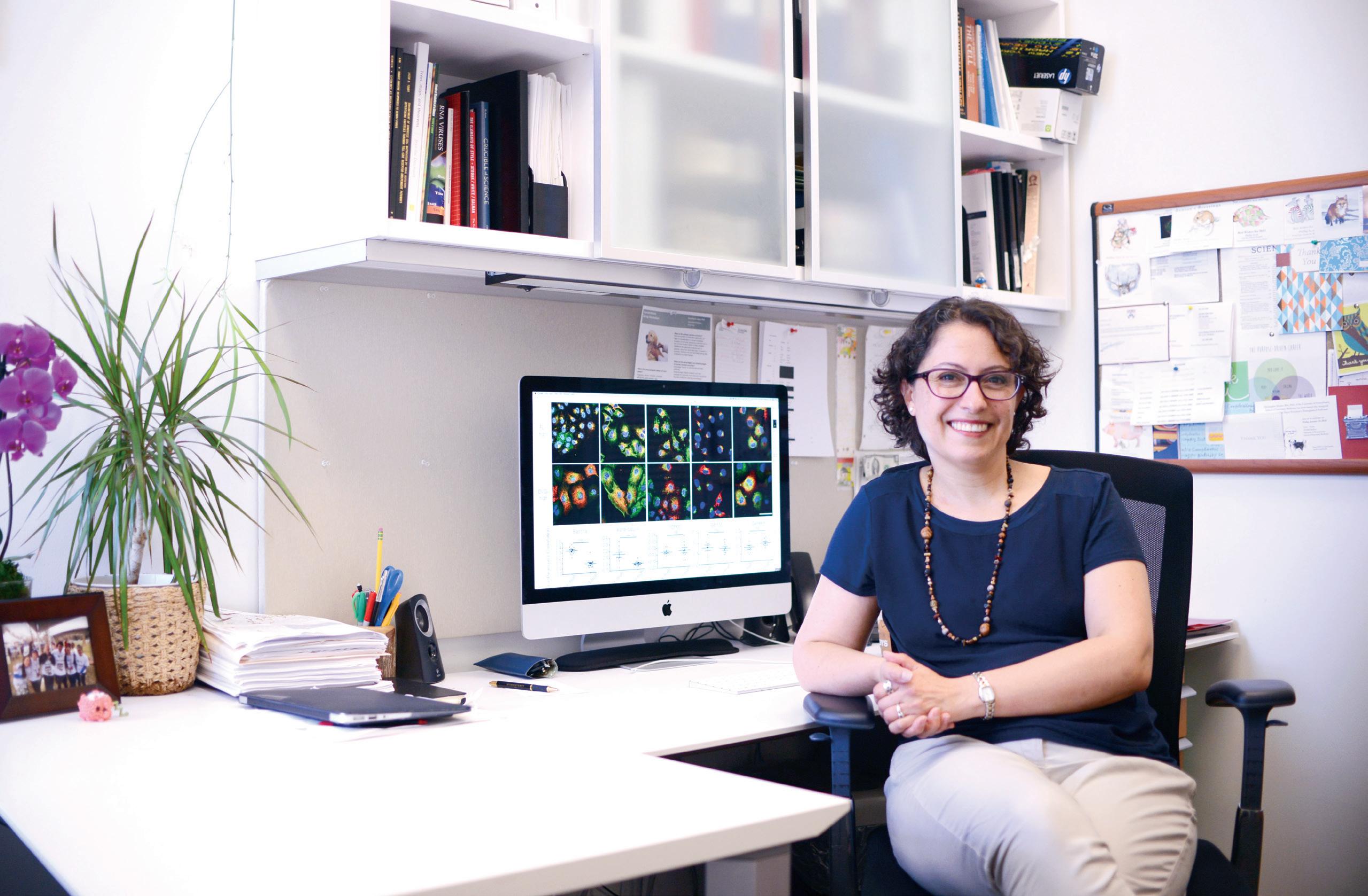
THE LÓPEZ LAB STUDIES THE INTERPLAY BETWEEN VIRUSES AND THE IMMUNE SYSTEM THAT PROTECTS US FROM INFECTIONS.
1

She’s a gift from my sons. Wonder Woman is very wonderful! I sometimes wish I had superpowers—super patience would be a great power to have. We always called our kids, who are in college now, our little Smurfs—one of the boys played piano and one played soccer when they were little.

2
A friend of my mother does beautiful needlepoint and made this hill in Valparaiso. I grew up in a small city in Chile called Antofagasta—it was in the desert but near the sea. My husband and I came to the U.S. in 1996 for our PhDs, and this lovely piece reminds me of where I’m from.
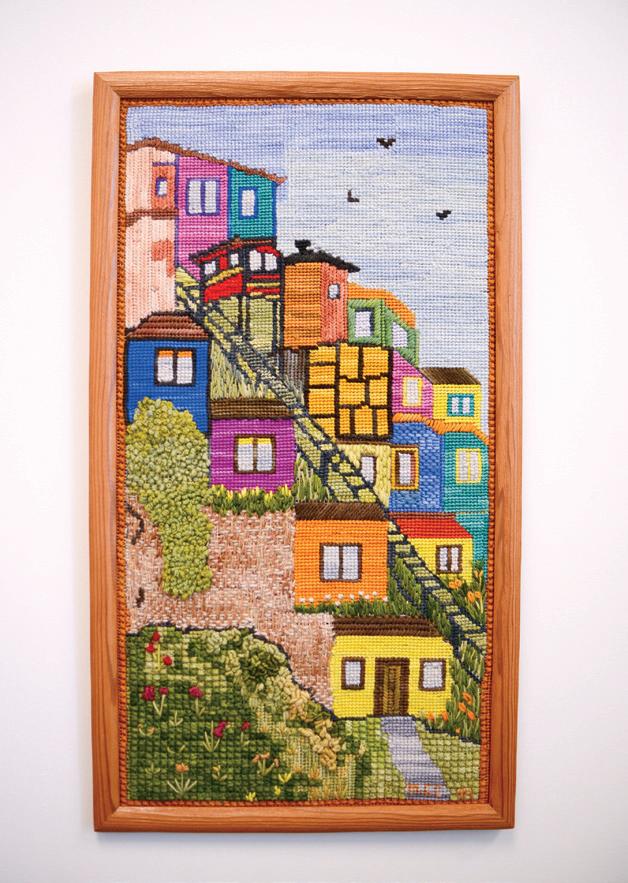
3
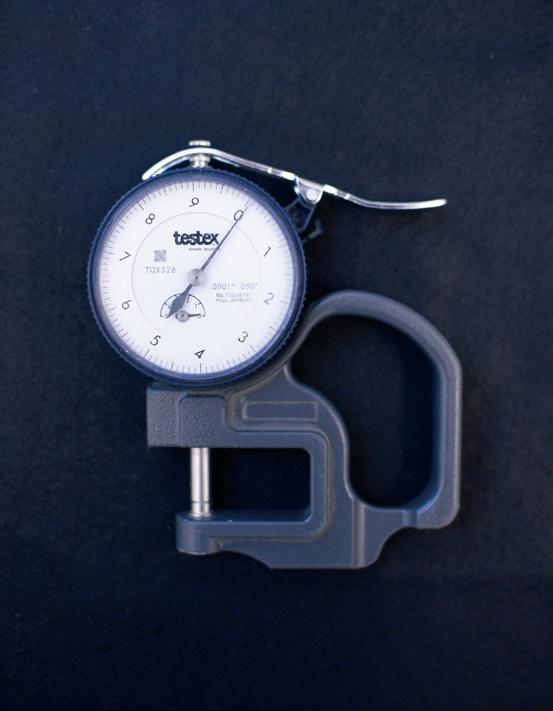
My husband gave this to me when I received tenure. I used an instrument like this all the time in the first lab that I joined to measure inflammatory reactions in mouse ears. The tool is very precise and measures at the millimeter level. I used it so much at one point I couldn’t use my right hand for about six months. The equipment is cool and really marks the first real science I did. Today, I do more virology work and don’t use this type of tool, so this is part of my history.
4


The group illustration is from an undergrad Penn student who worked in my lab. It’s of all the people in the lab at the time she was here, and she really captured everyone’s characters. The other three are from another undergraduate who completed a three-year PREP program. He painted one for each year he was here. It always amazes me when students create things that show another side of them.
5
A young virologist colleague loves to knit and hands around these during conferences and meetings. He made me this virus. It’s perfect, because it’s defective and we work with defective viruses. Initially, he made it defective by making it small, but eventually the knitting popped and unraveled at the top, making it a truly defective knit virus.

I was on sabbatical last year in Paris as a Fulbright Scholar at the Institut Pasteur, where I studied mathematical modeling. The group I studied with uses math to model the dynamics of infectious diseases. This is something we haven’t really done in my lab, but the research is moving in that direction. It was fascinating to see the different approach. So many times, I’d marvel at the difference—I’d talk about how viruses infect a cell, and they’d think of a possible equation for it. The Eiffel Tower was the present from my secret Santa. It has the name of everyone in that lab.
7 LOVE RUN PHILADELPHIA MEDAL
I raced with my lab a few years ago. We had two teams and ran the relay 10K course. There were a range of running levels among us, and we had to work together as team. I don’t think that I could convince everyone to do it again, but it was a fun experience and great team activity.


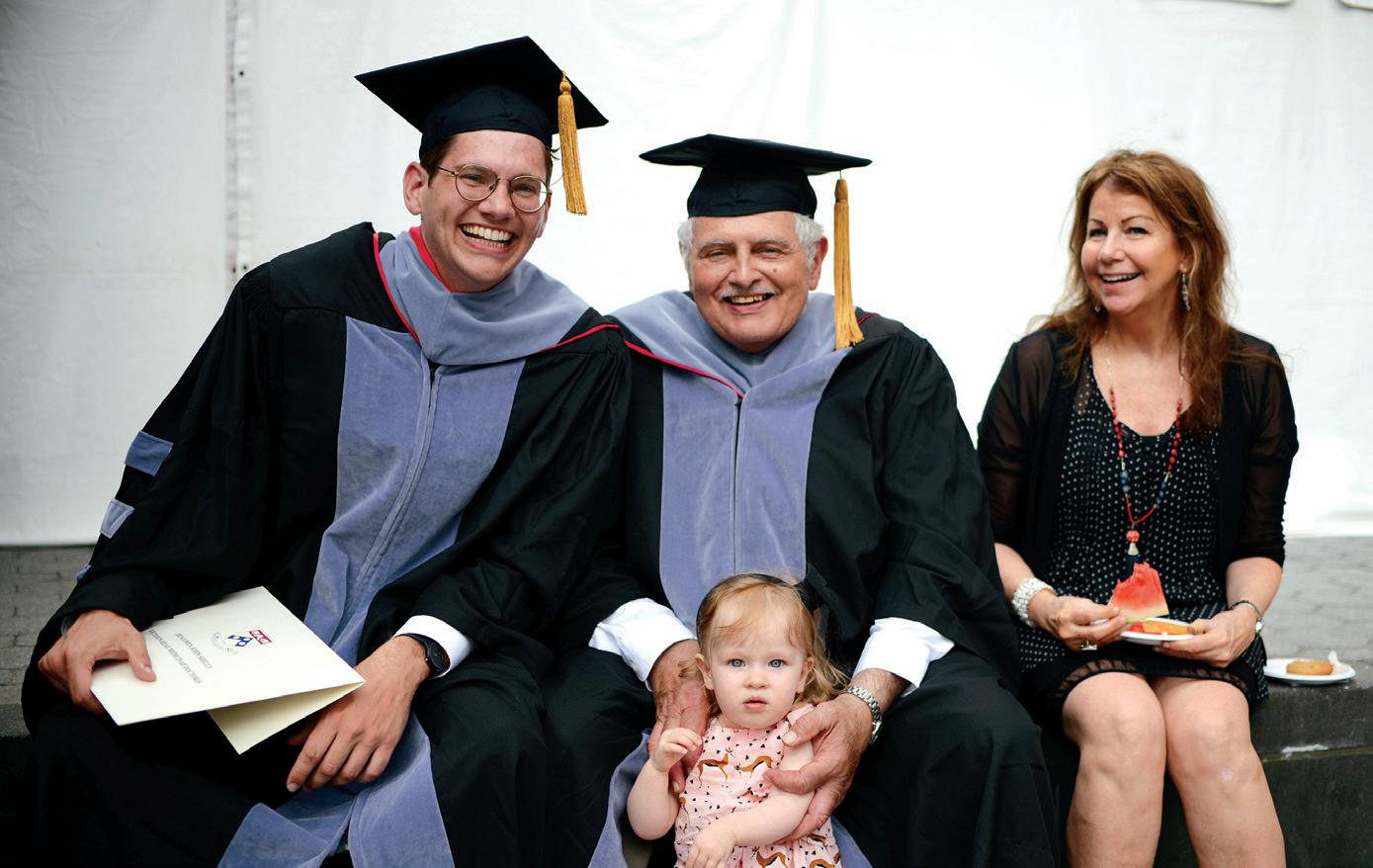

“THE ANIMAL WORLD IS BORDERLESS, SPANNING THE URBAN AND RURAL, SERVED AND UNDERSERVED. YOUR IMMERSIVE EXPERIENCES AT PENN VET WILL SERVE YOU WELL IN MAKING LIFE CHOICES, SUPPORTING YOUR COMMUNITIES, PROMOTING INCLUSION, BREAKING DOWN BORDERS.”
DEAN ANDREW HOFFMAN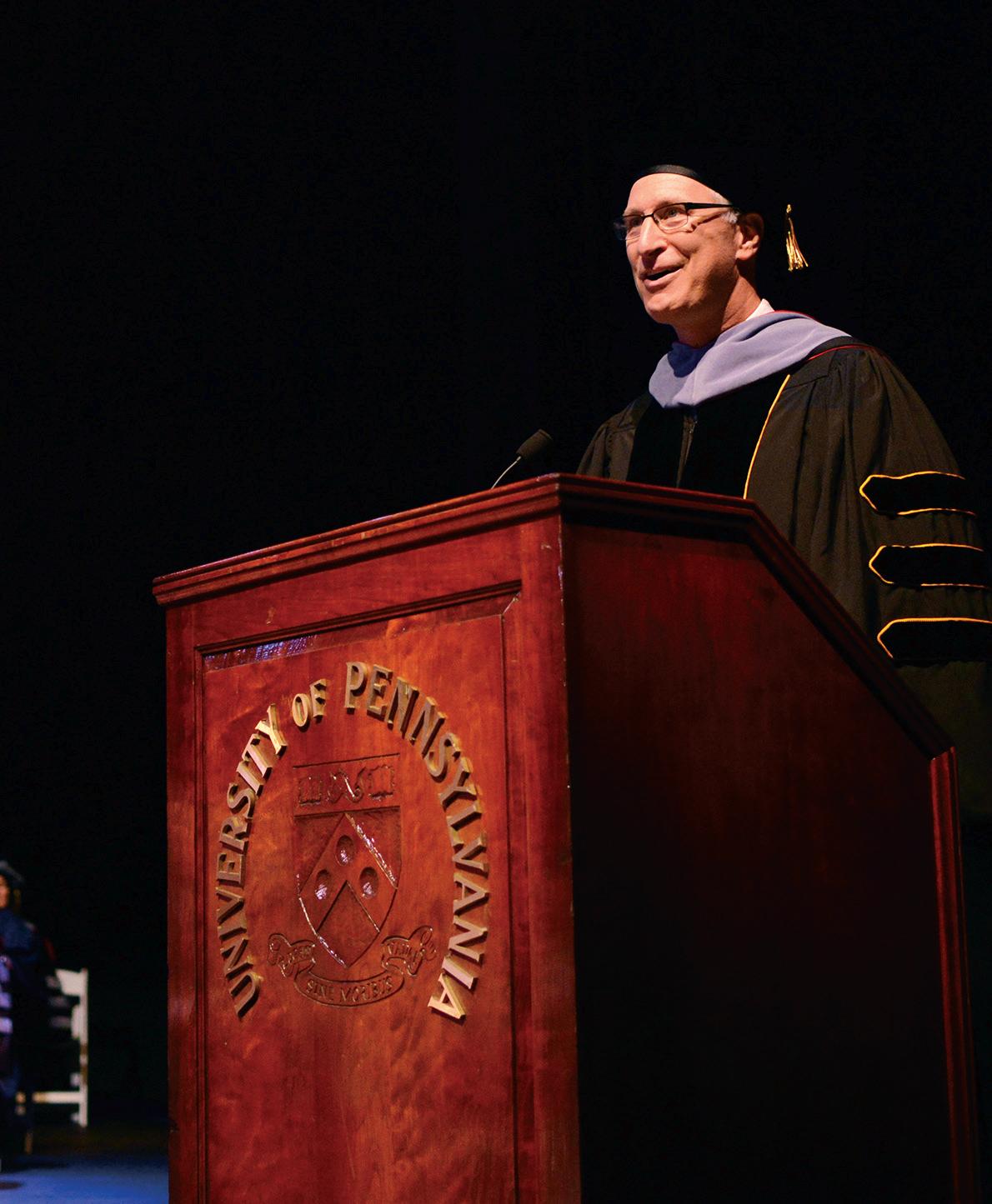
“TODAY MARKS A MILESTONE IN OUR PROFESSIONAL CAREERS, BUT THE LEARNING DOES NOT STOP HERE, AND NEITHER DOES OUR LEGACY. . .WE’VE UNDOUBTEDLY LEFT OUR MARK AT PENN VET, AND IT IS TIME TO CARRY ON THE LEGACY IN THE REST OF THE COUNTRY AND BEYOND.”
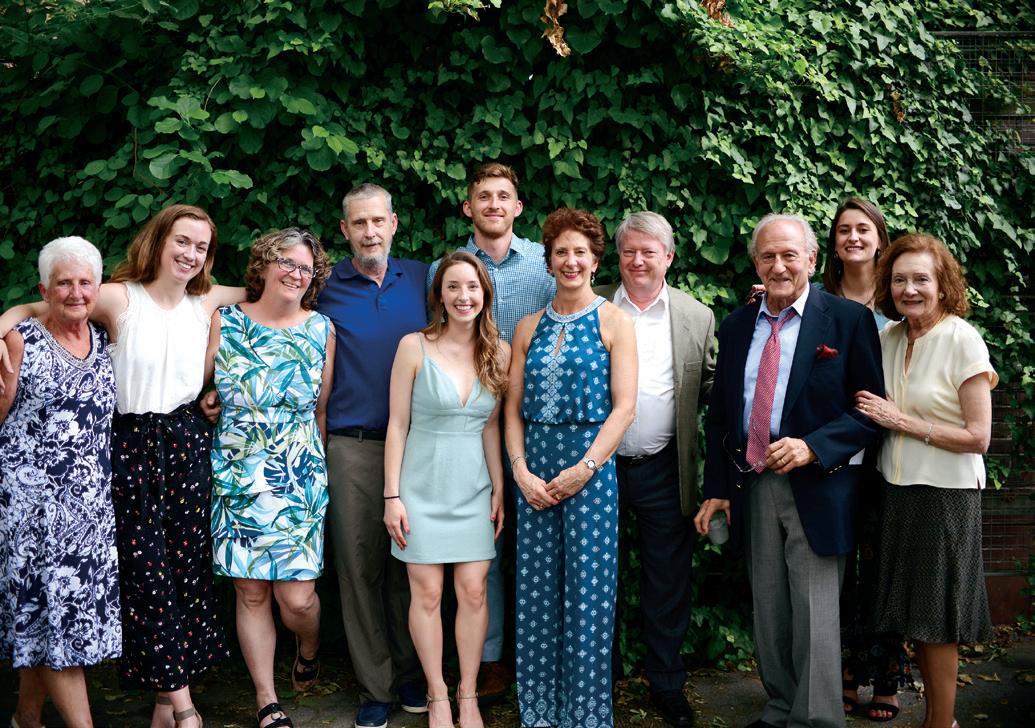
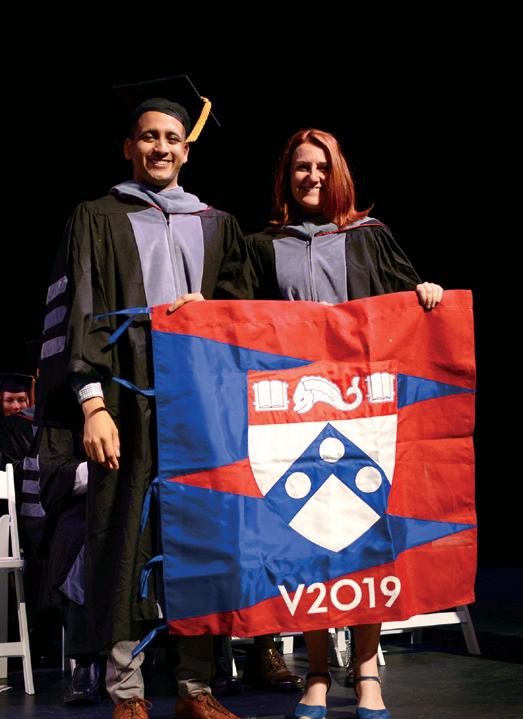

 FELIPE GARCIA, V’19, SAVMA CLASS PRESIDENT
FELIPE GARCIA, V’19, SAVMA CLASS PRESIDENT


This year’s 25th faculty research retreat focused on Social Entrepreneurship in Research. Dr. Dan Rader, Seymour Gray Professor of Molecular Medicine, Perelman School of Medicine, delivered the Marshak Lecture: A Genome-First Approach to Understanding Biology, Disease, and Therapeutic Targets. A newly added Poster Blitz featured 24 poster presentations, one-minute pitches by each participant. Winners were: Dr. Snahlata Singh, Rumela Chakrabarti laboratory (first place); Christina Cho, Serge Fuchs laboratory (second place); Dr. Sho Yoshimoto, Nicola Mason laboratory and Dr. Ratnesh Srivastava, Rumela Chakrabarti laboratory (tied for third place). Dr. Ellen Puré awarded the Zoetis Prize for Veterinary Research Excellence to Dr. Serge Fuchs.

For three days in June, 17 people from veterinary academic institutions, private practice, and nonprofits attended Penn Vet’s Leading Veterinary Entrepreneurship executive program.
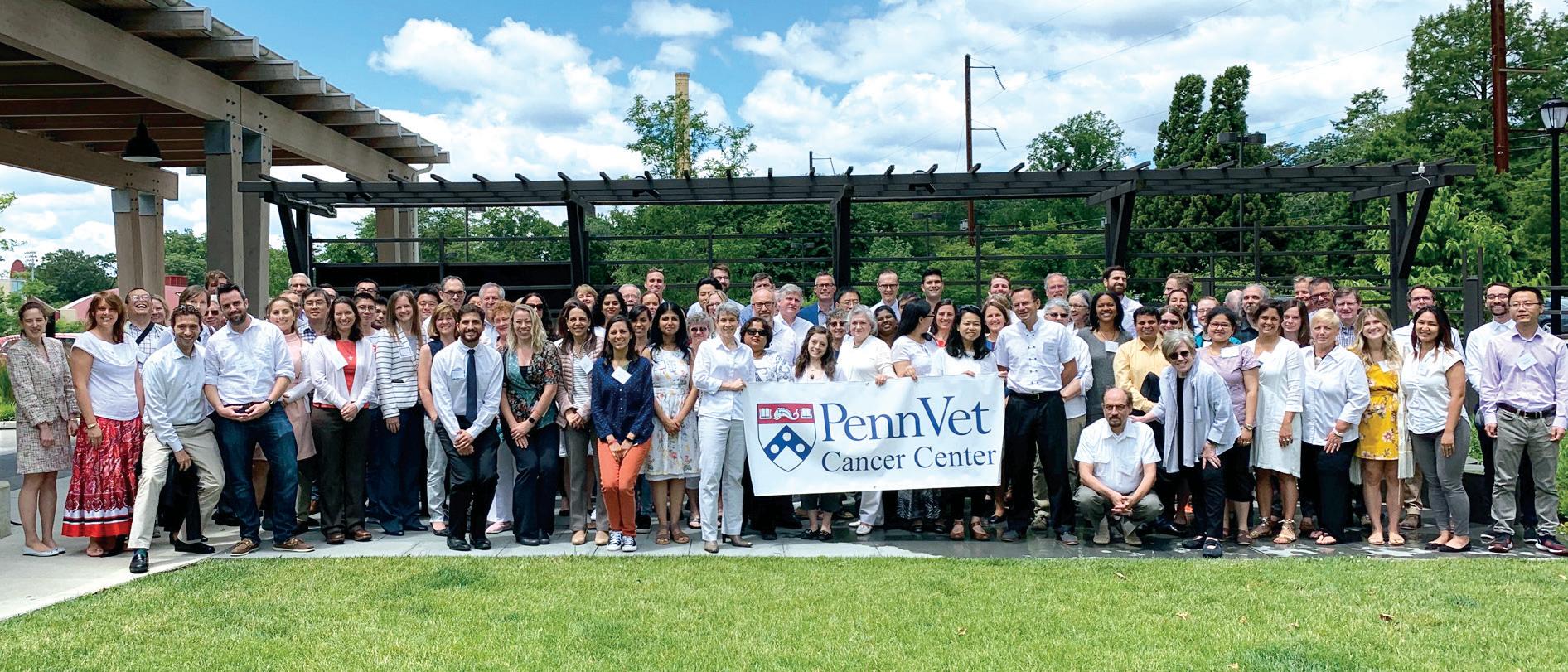
This latest addition to Penn Vet’s continuing education portfolio is designed to help attendees cultivate an entrepreneurial mindset outside their area of expertise. The program introduces foundational skills necessary to develop a new product or service with growth potential, or to identify opportunities within an existing organization.

2019 marks the 50th anniversary of the Penn Vet VMD-PhD program. In commemoration, over two days in March, the School hosted its annual Student Research Day along with a VMD-PhD 50th Anniversary Symposium. Student Research Day winners included Rebecca Rosenthal; Mariel Covo V’20; John Cain, V’20; Ian Penkala, VMD-PhD ’21; Katherine Neupauer, V’21; Robyn Allen; Monica Jimenez; Pierce Nathanson; and Philip Hicks. The symposium featured keynote speaker Dr. Ralph Brinster, alumni talks, networking sessions, and four esteemed Penn Vet deans: Robert Marshak, Alan Kelly, Joan Hendricks, and Andrew Hoffman.



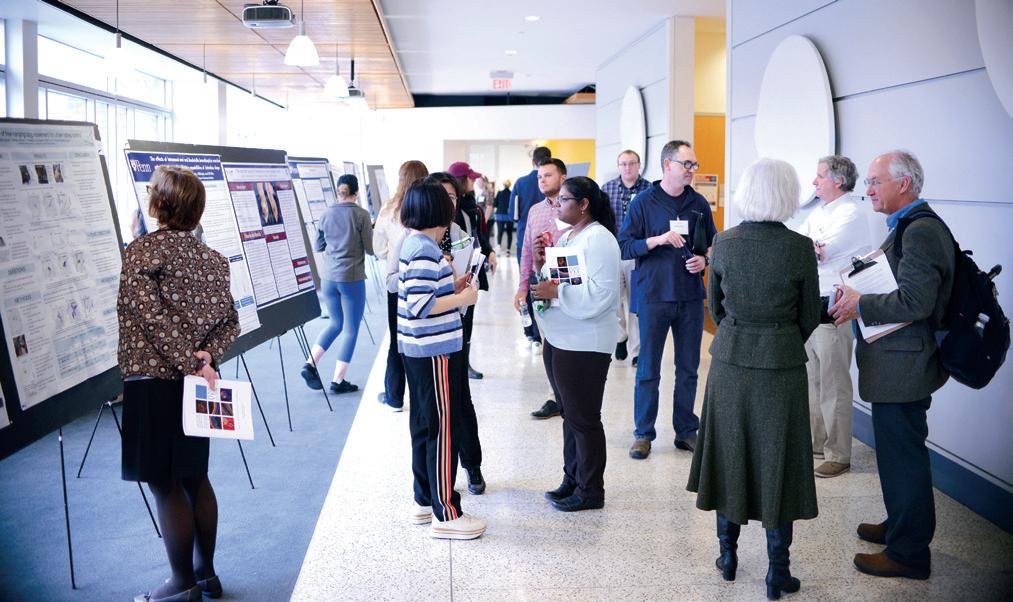
Michelle Abraham, BVMS, was appointed Assistant Professor of Clinical Large Animal Emergency and Critical Care.
Kimberly Agnello, DVM, was promoted to Associate Professor of Small Animal Surgery.
Gustavo Aguirre, VMD, PhD, received the Dorothy Harrison Eustis Humanitarian Award at the 90th Anniversary Gala of the Seeing Eye Inc.
Maia Aitken, DVM, was appointed Assistant Professor of Clinical Large Animal Emergency and Critical Care.

Gary Althouse, DVM, PhD, was appointed to Associate Dean of Sustainable Agriculture and Veterinary Practices. He also gave an invited talk on mycotoxicosis and its control in boars at the American Association of Swine Veterinarians Annual Meeting in March 2019 in Orlando, Florida.
Montserrat Anguera, PhD, was promoted to Associate Professor of Biomedical Sciences.

Matt Atherton, BVSc, PhD, presented an invited talk entitled Unleashing Anticancer
T Cells: Is Strength in Numbers Enough? at the American College of Veterinary Internal Medicine’s Science of Veterinary Oncology meeting in Las Vegas in April 2019. The talk described next generation cancer immunotherapy trials being performed at Penn Vet, including vaccination and CAR T cell-based approaches for companion animals.
Ashley Boyle, DVM, spoke on Viability
Detection of Streptococcus equi: The Serologic Response to a Modified Live Intranasal Vaccine at the Havemeyer Foundation
Workshop Getting to Grips with Strangles and Other Streptococcal Diseases, in Reykjavik, Iceland, May 2–5, 2019. In addition, she was the co-chair of the American College of Veterinary Internal Medicine Forum in Phoenix, Arizona. She was the author of chapters on Streptococcus equi, vaccinations, and purulent nasal discharge as well as the editor of the infectious disease section in Hinchcliff K and Lavoie JP (eds.), Blackwell’s Five-Minute Veterinary Consult: Equine, 3rd edition. And she was the author of the chapter on Streptococcus equi (strangles), in Smith, BP, Large Animal Internal Medicine, 6th edition.
Samuel Chacko, BVSc, PhD, was reappointed as a chartered member of the NIDDK-D Study Section. He is an emeritus professor in the Department of Pathobiology.
Rumela Chakrabarti, PhD, published Snahlata Singh, Emily Elenio, Adrian N. Leu, Rose-Anne Romano, Andrew Vaughan, Jennifer DeRiso, Kameswaran Surendran, and Rumela Chakrabarti, A New Elf5CreERT2 BAC Transgenic Mouse Model for Tracing Elf5 Cell Lineages in Adult Tissues, FEBS Letters, April 2019. She also published Snahlata Singh and Rumela Chakrabarti, Consequences of EMT-Driven Changes in the Immune Microenvironment of Breast Cancer and Therapeutic Response of Cancer Cells, J Clin Med, May 2019.
Molly Church, DVM, PhD, and Koranda Walsh, VMD, with financial support from the dean’s office and the Netter Center for Community Partnerships, hosted elementary students from West Philadelphia for the six-week This Is How We “Role” summer school program. The program connects children from backgrounds historically underrepresented in veterinary medicine with veterinary students from Penn Vet. Children are introduced to anatomy, internal medicine, and parasitology.
Barbara Dallap Schaer, VMD, was promoted to Professor of Emergency Medicine and Critical Care.
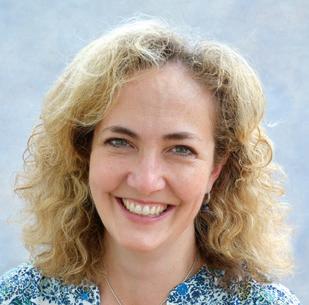
Bernd Driessen, DVM, PhD, works at the European School for Advanced Veterinary Studies (ESAVS) as course master for the Asian program in Small Animal (SA) Anesthesia and Analgesia, including two weeklong courses per year in Shanghai. Driessen is also ESAVS course director for a four-module SA Anesthesia and Analgesia certificate program for European veterinary technicians. Driessen is heading an SA and Equine Anesthesia and Analgesia certificate program administered by Narkovet Consulting and Ethos Veterinary Health/VetBloom in collaboration with Cornell University, Manor College, Rood and Riddle Equine Hospital, and Pferdeklinik Leichlingen. He is joined by a team of over twenty leaders in the fields of anesthesia, analgesia, and emergency/critical care from four continents who serve as co-lecturers in the North American, European, and Asian programs and share his vision of promoting and advancing the anesthesia and analgesia care that animals deserve. Driessen has also been invited by the Chinese Agricultural University and Veterinary Medical Association to join a task force of international consultants to help form a Chinese Board of Veterinary Specialization.
Oliver Garden, BVetMed, PhD, was inducted into the College of Physicians of Philadelphia as a Fellow.
Anna Gelzer, DrMedVet, PhD, was promoted to Professor of Cardiology.

Karina Guziewicz, PhD, presented at the 2019 Investing in Cures Summit in Cary, North Carolina. She also made two presentations at the 2019 Annual Meeting of the Association for Research in Vision and Ophthalmology in Vancouver: Safety and Long-Term Efficacy of AAV2-BEST1
Gene Augmentation Therapy in Canine Model of Best Vitelliform Macular Dystrophies and Exploring Controversial Issues in BEST1-
Related Retinal Disease: Lessons from Canine Model of Best Disease. In addition, she was reappointed as Research Assistant Professor.
Rebecka Hess, DVM, MSCE, received the Christian R. and Mary F. Lindback Award for Distinguished Teaching and the Class of 2020 Award for Excellence in Teaching, Philadelphia Campus. She published JD Anderson, DA Rondeau, RS Hess, Lispro Insulin and Electrolyte Supplementation for Treatment of Diabetic Ketoacidosis in Cats, J Vet Intern Med, 2019;1-9. https:// doi.org/10.1111/jvim.15518. She also published MJ Lechner and RS Hess, The Utility of Serum, Plasma, and Whole Blood Glucose Measurement on a Point-of-Care Glucometer: A Prospective Study of 152 Samples from Dogs and 111 Samples from Cats, in press, American Journal of Veterinary Research, 2019. She also published SV Cai, TR Famula, AM Oberbauer, RS Hess, Heritability and Complex Segregation Analysis of Diabetes Mellitus in American Eskimo Dogs, in press, J Vet Intern Med, 2019.
Samuel Hurcombe, BVMS, MS, was appointed Associate Professor of Large Animal Emergency and Critical Care.

Amy Johnson, DVM, was promoted to Associate Professor of Medicine and Neurology.
Allison Kyler, LVT, completed and passed all phases of the Certification of Canine Rehabilitation Program through the University of Tennessee. She is now certified in canine rehabilitation, CCRP.
Meryl Littman, VMD, spoke about the similarities and differences between leptospirosis and Lyme nephritis at the American College of Internal Veterinary Medicine (ACVIM) National Forum in Phoenix in June.
Carolina López, PhD, published Sun Y, Kim EJ, Felt SA, Taylor LJ, Agarwal D, Grant GR, and López CB, A Specific
Sequence in the Genome of Respiratory Syncytial Virus Regulates the Generation of Copy-Back Defective Viral Genomes
[Preprint: bioRxiv 349001], PloS Pathog 15(4): e1007707. doi.org/10.1371/journal. ppat.1007707. She also published López CB, Unexpected Lessons from the Neglected: How Defective Viral Genomes Became Important Again, Research Matters, PLoS Pathog, 15(1):e1007450. doi.org/10.1371/ journal.ppat.1007450. She also published Genoyer, E, and López, CB, The Impact of Defective Viruses on Infection and Immunity, Ann. Rev. Virol, May 13, 2019. doi: 10.1146/ annurev-virology-092818-015652.
PMID: 31082310. And she published Vignuzzi M and López CB, Defective Viral Genomes Are Key Drivers of the Virus-Host Interaction, Nature Microbiology, Jun 3, 2019. doi: 10.1038/s41564-019-0465-y. PMID:31160826.

Olivia Lorello, VMD, PhD, was appointed Assistant Professor of Clinical Field Service.
James Marx, DVM, PhD, was promoted to Associate Professor of Laboratory Animal Science.

Nicola Mason, BVetMed, PhD, was designated as the Paul A. James and Charles A. Gilmore Endowed Chair Professor.
Keiko Miyadera, DVM, PhD, was invited to give a talk on Recent Advances in Inherited Ocular Diseases in Animals at the Canine and Feline Genetics Forum at the University of Tokyo in March 2019.
Daniel Morris, DVM, MPH, published Radwanski NE, Morris DO, Boston RC, Cerundolo R, Lee KW, Longitudinal Evaluation of Immunological Responses to Allergen-Specific Immunotherapy in Horses with IgE Associated Dermatological Disease, A Pilot Study, Vet Dermatol 2019;30(3):255-e78.
Ariel Mosenco, DVM, was promoted to Professor of Clinical Medicine.
In July, Dr. Patricia Mundy, Staff Veterinarian, Ophthalmology, spoke at the Royal College of Veterinary Surgeons’ (RCVS) annual Royal College Day about Navigating Diversity and Inclusion in the Veterinary Profession.
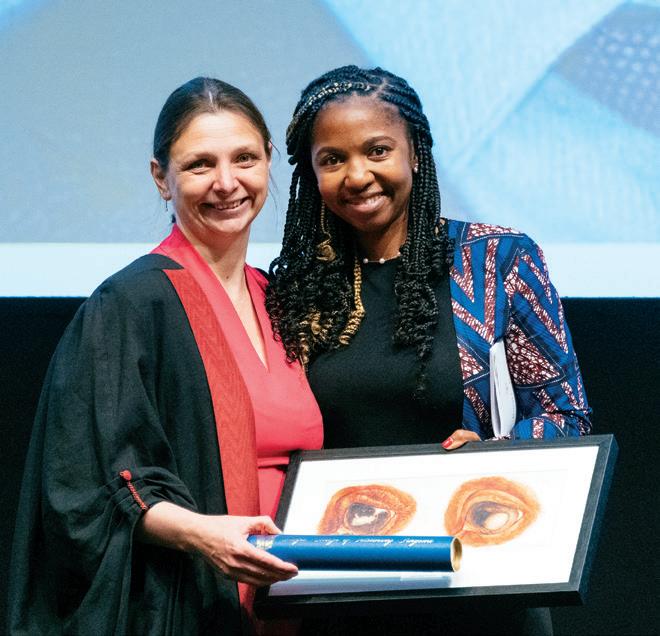
“It’s time for inclusive environments across all professions — a systematic approach to achieving meaningful diversity and inclusion in the veterinary profession is essential,” she said.
“Our profession requires diverse practitioners who reflect the communities we serve.”

Cynthia Otto, DVM, PhD, was promoted to Professor of Working Dog Sciences and Sports Medicine. She received the International Canine Sports Medicine Symposium Mark Bloomberg Award. In addition, she published Lyons B, Ateca L, Otto CM, Clinicopathologic Abnormalities Associated with Increased Animal Triage Trauma Score in Feline Bite Wound Patients: 43 cases (1998-2009), JVECC 2019; 1-5. https://doi.org/10.1111/ vec.12831. She also published Goucher TK, Hartzell AM, Seales TS, Anmuth AS, Zanghi BM, Otto CM, Skin Turgor and Capillary Refill Time as Predictors of Dehydration in Exercising Dogs, Am J Vet Res 2019;80:123–128.
Thomas Parsons, VMD, PhD, was promoted to Professor of Swine Production Medicine.

Laurel Redding, VMD, PhD, published LE Redding, S Cole, Pet Owner Knowledge of and Attitudes Toward the Judicious Use of Antimicrobials in Companion Animals, Journal of the American Veterinary Medical Association, 2019, 254 (5): 626-635. She also published LE Redding, S Lavigne, H Aceto, R Nolen-Walston, Characterization of Antimicrobial Prescription Frequency and Diversity in a Large Animal Veterinary Medical Teaching Hospital, Prev Vet Med, 2019, 168:66-74.
Alexander Reiter, DrMedVet, DiplTzt, gave lectures and tutored laboratories to veterinarians and veterinary technicians at the British Veterinary Dental Association Scientific Meeting in Birmingham, United Kingdom; the Congress of the Austrian Society of Veterinary Dentistry in Innsbruck, Austria; and the European Veterinary Dental Forum in Utrecht, Netherlands.
Pascale Salah, DVM, was promoted to Associate Professor of Clinical Comprehensive Cancer Care.
Dieter Schifferli, DrMedVet, PhD, published Rakov AV, Mastriani E, Liu SL, Schifferli DM, Association of Salmonella Virulence Factor Alleles with Intestinal and Invasive Serovars, BMC Genomics 2019 May 28;20(1):429. doi: 10.1186/ s12864-019-5809-8. PubMed PMID: 31138114; PubMed Central PMCID: PMC6540521. He also published Pan H, Zhou X, Chai W, Paudyal N, Li S, Zhou X, Zhou K, Wu Q, Wu B, Li G, Rajkovic A, Fang W, Rankin SC, Li Y, Xu X, Schifferli DM, Yue M, Diversified Sources for Human Infections by Salmonella Enterica Serovar Newport, Transbound Emerg Dis, 2019 Mar;66(2):10441048. doi: 10.1111/tbed.13099. Epub 2019 Jan 7. PubMed PMID: 30548172; NIHMSID:NIHMS1032122.
Patricia Sertich, VMD, chaired the 2019 American College of Theriogenologists (ACT) Certifying Examining Committee, which hosted the ACT Certifying Examining Committee retreat at the Allam House, New Bolton Center, January 7–11, 2019. Retreat participants included Drs. Joann Randall (Woodstock, Illinois), Ahmed Tibary (Washington State University), Julie Cecere (Virginia-Maryland Regional College of Veterinary Medicine), Vice Chairman Brian Whitlock (University of Tennessee), Jack Smith (Mississippi State University), and Reed Holyoak (Oklahoma State University). New Bolton Center staff member Tyler Harold provided IT assistance and Dee Crandall and Margy Lindem facilitated reference library support.
Deborah Silverstein, DVM, lectured at VetCo in Warsaw, Poland, March 2–3, 2019.
Gary Smith, MA(Oxon), MA(Cantab), D. Phil, PGCE, Emeritus Professor of Population Biology and Epidemiology, spoke about Agroterrorism: The Changing Context and the Crystal Ball Problem at the four meetings of the first annual
Pennsylvania Anti-Terrorism Advisory Council Conference, held in Philadelphia, State College, Reading, and Pittsburgh. The conference was jointly organized by the Department of Justice Offices of the US Attorneys, the Office of Homeland Security (Pennsylvania), and the Federal Bureau of Investigation.
Louise Southwood Parente, BVSc, PhD, was promoted to Professor of Emergency Medicine and Critical Care.
Boris Striepen, PhD, had numerous speaking engagements between January and June 2019, including the Dean’s Visiting Distinguished Lecturer series, Perelman School of Medicine, University of Pennsylvania; NIH Emerging Diseases Meeting, Hanoi, Vietnam; Cell Pathology Seminar, Children’s Hospital of Philadelphia; Gordon Research Conference on Tropical Infectious Diseases, Galveston, Texas; Department of Molecular Microbiology and Immunology, Johns Hopkins University, Baltimore; American Society for Biochemistry and Molecular Microbiology Meeting, Orlando; Department of Microbiology, University of Chicago; Department of Microbiology, New York University School of Medicine; Penn Vet Research Retreat, New Bolton Center; Keynote, BIOCEV, Charles University Prague, Czech Republic; and the 7th International Giardia & Cryptosporidium Conference, Rouen, France. In addition, he published Baragaña B, et al, Lysyl-tRNA Synthetase as a Drug Target in Malaria and Cryptosporidiosis, Proc Natl Acad Sci USA, 2019 Apr 2;116(14):7015-7020.
Corinne Sweeney, DVM, is the new chairwoman of the Association of Racing Commissioners International (RCI). The RCI is composed of the governmental regulators of horse and greyhound racing in the United States, Canada, Mexico, Jamaica, Trinidad-Tobago, and the Equestrian Club of Riyadh, Saudi Arabia.



Regina Turner, VMD, PhD, was promoted to Professor of Reproduction.
Charles Vite, DVM, PhD, spoke at the Gordon Conference on Lysosomal Storage Disease in Galveston Texas, Ara Parseghian Medical Research Conference in Tucson, the ACVIM meeting in Phoenix, and the International Niemann Pick Disease Alliance in Lyon, France. He also reports that Lovelace Biomedical has teamed with the National Referral Center for Animals Models of Human Genetic Disease (RCAM) at Penn Vet, as well as with Jackson Laboratory, Exemplar Genetics, and Iontox to win a new $17 million contract with the National Institute of Health’s (NIH) National Center for the Advancement of Translational Sciences to better understand and study diseases and treatments for rare and neglected diseases. The combined capabilities of the team members represent some of the best talent in the world to help the NIH in creating or characterizing novel disease models to address unmet needs. Rare diseases have been difficult to fight without proper pharmacological resources, indicates Dr. Jake McDonald, Principal Investigator of the overall contract. The discoveries that come from this contract will help advance new therapeutics and create new resources to better understand the natural history of these rare diseases. Vite also caught a really big fish last weekend. Really big.
Brittany Watson, VMD, PhD, and Chelsea Reinhard, DVM, MPH, spoke on EvidenceBased Decision Making and Strategic Planning: Powerful Tools for Increasing Your Impact in May 2019 at the Federated Humane Societies of Pennsylvania’s First Annual Conference in Harrisburg, Pennsylvania.
Jorge Alvarez, PhD, received a $150,000 ITMAT Pilot Grant for T Cell Based Therapy to Target B Cells within the Central Nervous System. The grant spans from February 1, 2019 to January 31, 2020. He also received a $90,000 grant from EMD Serono for Defining the Role of Anti-B Cell Therapies in Meningeal Inflammation. The grant spans from February 4, 2019 to February 3, 2020.

William Beltran, DVM, PhD, received a $380,918 grant from the Foundation for Fighting Blindness–Canada for Preclinical Evaluation of an iPSC-Derived Photoreceptor Therapeutic in Canine Model of Retinitis Pigmentosa. The grant spans from January 9, 2019 to December 31, 2020. He received another grant for $250,000 from the foundation for RV-20/20- Development of a Neogenin Based-Strategy to Prevent Photoreceptor Degeneration. The grant spans from July 1, 2019 to July 31, 2022.
Andres Blanco, PhD, received a $100,000 grant from the Leukemia Research Foundation for Dual Targeting of LSD1 and KAT6A to Induce Therapeutic Differentiation in AML. The grant spans from July 1, 2019 to June 30, 2020. He also received a $573,844 NIH/NCI K22 grant for The Role of the Histone Chaperone Chaf1b in Sustaining the Hoxa9-Driven AML Differentiation Block. The grant spans from September 1, 2018 to August 31, 2021.
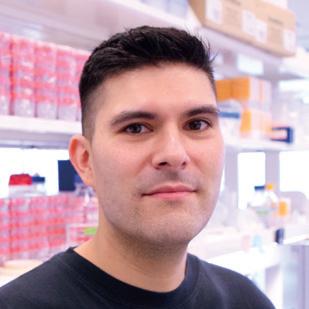
Igor Brodsky, PhD, received a $10,089 grant from the Mark Foundation for Rational Design of Novel Combination Immunotherapies: Enhancing the Cytotoxic Activity of Chimeric Antigen Receptor T Cells Using the SMAC Mimetic Birinapant. The grant spans from February 4, 2019 to August 31, 2020.
Christine Cain, DVM, received a $41,192 grant from the Companion Animal Research Fund for Fosmidomycin for Treatment of Canine Otitis Extern. The grant spans from January 1, 2019 to December 31, 2020.

Rumela Chakrabarti, PhD, received a $792,000 grant from the American Cancer Society for DLL1 Mediated Notch Signaling in Tamoxifen Resistance of Breast Cancer. The grant spans from July 1, 2019 to June 30, 2023. She also received a five year $1,250,000 R01 grant from the NIH-NCI.

Molly Church, VMD, PhD, received a $79,600 grant from the American Kennel Club Canine Health Foundation for a Comparative Brain Tumor Consortium (CBTC) Meningioma Pathology Study to identify prognostic and therapeutic biomarkers for canine patients and will generate uniformity in diagnosis across institutions. A grading and classification scheme will be developed for canine meningioma to help define prognostic outcome and prospectively integrate tumor morphology, immune cell infiltrate, and epigenetic profiles with genomic data obtained from a robust collection of canine tumors. The grant spans from April 1, 2019 to March 31, 2020. Her collaborators are Amy LeBlanc, DVM, National Institutes of Health/National Cancer Institute/ Center for Cancer Research/Comparative Oncology Program, and Andrew Miller, DVM, Cornell University.
Dana Clarke, VMD, received a $26,552 grant from the Companion Animal Research Fund for Incidence of Pharyngeal Collapse and Effect of Corrective Upper Airway Surgery in Symptomatic Brachycephalic Dogs. The grant spans from January 1, 2019 to December 31, 2020.
Raimon Duran-Struuck, DVM/PhD, received a $45,000 PICAB pilot grant for Development of Clinically Relevant Swine Tumor Model through Genetic Modification of Porcine Lymphohematopoietic Cancers. The grant spans from March 1, 2019 to February 28, 2020.
Bruce Freedman, VMD/PhD, received a $275,000 NIH/AI R21 grant for Novel Mechanisms of c-Rel Dependent Thymic Regulatory T Cell Development. The grant spans from June 21, 2019 to May 31, 2021.

Anna Gelzer, PhD, DrMedVet, received a $20,552 grant from the Companion Animal Research Fund for Determination of Anti-Arrhythmic Efficacy of Sotalol and Amiodarone in Boxers with ARVC by Electrophysiologic Testing, Electroanatomic Mapping, and Novel ECG Monitoring. The grant spans from January 1, 2019 to December 31, 2020.
Karina Guziewicz, PhD, received a $556,715 grant from Iveric Bio, Inc. for Gene Therapy for BEST1-Associated Macular Dystrophies—Projects 1–3. The grant spans from January 30, 2019 to January 28, 2021. She also received a $522,204 grant from Iveric Bio, Inc. for Gene Therapy for BEST1-Associated Macular Dystrophies (4 Workstreams/SubProjects). The grant spans from February 12, 2019 to March 3, 2021. And she received a $150,000 NEI-NIH grant for The Role of a Novel Scaffold Protein in Mediating RPE Phagocytosis of Photoreceptor Outer Segment. The grant spans from March 1, 2019 to February 28, 2021.
Ronald Harty, PhD, received a $196,932 grant from Intervir LLC/Welcome Trust for Development of Host-Oriented Therapeutics Against Hemorrhagic Fever Viruses. The grant spans from January 1, 2019 to December 31, 2020.
De’Broski Herbert, PhD, received a $150,000 grant from NIH for Using Transgenic Parasitic Nematodes to Investigate Type 2 Immunity. The grant spans from January 15, 2019 to December 31, 2020. His collaborator is James Lok, PhD.
Christopher Hunter, PhD, received a $275,000 NIH R21 grant for Novel Role of DC1 in Vaccine Induced CD8 T cell Responses. The grant spans January 4, 2019 to December 31, 2020. His collaborator is David Christian, PhD. He received another $275,000 NIH R21 grant for The Role of Endothelial and T Cells during Infection of the Vascular Compartment. The grant spans from January 8, 2019 to December 31, 2020. His collaborator is Christoph Konradt, PhD. And he received a $69,650 grant from Surface Oncology for Role of Anti IL-27p28 Antibody during Toxoplasmosis. The grant spans from March 19, 2019 to September 19, 2020.

Anna Kashina, PhD, received a $522,269 NIH/NINDS grant for Role of Arginylation in Prevention of Alpha Synuclein Driven Neurodegeneration. The grant spans from April 15, 2019 to March 31, 2024.


Jennifer Lenz, DVM, received a $74,303 grant from the Companion Animal Research Fund for Defining the Efficacy and Elucidating the Immunomodulatory Role of Alkylating Chemotherapeutics for Canine T-cell Lymphoma. The grant spans from January 1, 2019 to December 31, 2020.
James Lok, PhD, received a $1,250,000 NIH grant for Insulin-Like Signaling in Parasitic Nematode Development. The grant spans from November 9, 2018 to October 31, 2023. He also received a $50,000 grant from the University Research Foundation for Regulatable CRISPR/Cas9 Mutagenesis in Parasitic Nematodes. The grant spans from March 1, 2019 to February 28, 2020.
James Marx, DVM/PhD, received a $2,500 grant from the American Society of Laboratory Animal Practitioners Foundation for its Summer Fellowship Program, held from June 1 to August 31, 2019.
Nicola Mason, BVetMed, PhD, received a $134,189 grant from the Abramson Cancer Center for the Sarcoma Trichloroethylene Project. The grant spans from November 1, 2018 to October 31, 2020.
Michael May, PhD, received a $20,000 grant from the University Research Foundation for the VMD Symposium. The grant spans March 1, 2019 to February 28, 2020.
Keiko Miyadera, DVM, PhD, received a $99,303 grant from the American Kennel Club Canine Health Foundation for Characterization of Retinal Phenotypes and Their Association with RPGRIP1 and Modifiers in English Springer Spaniels. The grant spans from April 1, 2019 to March 31, 2021.
Daniel Morris, DVM, MPH, received a $1,229,455 R01HD097692 NICHD grant as a subaward with Johns Hopkins Bloomberg School of Public Health for Clinical Trial of a Disinfectant Intervention in Therapy Dogs to Combat HospitalAssociated Pathogens and Promote Sustainability of Animal-Assisted Visitation Programs. The grant spans from October 2018 to June 2023. His collaborators are James Serpell, PhD, Daniel Beiting, PhD, and Laurel Redding, VMD, PhD. He also received a $97,000 grant from Boehringer Ingelheim for Randomized Clinical Trial to Assess the Utility of Feline Interleukin-2 as an Adjuvant to Allergen Vaccines for the Treatment of Feline Atopic Dermatitis. The grant spans from February 2019 to December 2021. His collaborators are Christine Cain, DVM, Kathryn Rook, VMD, and Dermatology residents. He also received a $4,583 grant from the American College of Veterinary Dermatology
(ACVD) for Longitudinal Evaluation of the Atopic Feline Clinical and Immunological Response to Allergen-Specific Immunotherapy: A Randomized Clinical Trial. The grant spans from January 1, 2019 to December 31, 2019. His collaborator is Peter Canning, DVM. And he received a $9,950 grant from the ACVD for Clinical Trial to Assess the Utility of Serological and Skin Prick Allergen Testing for Cutaneous Food Sensitivity in Cats. The grant spans from January 1, 2019 to December 31, 2019. His collaborator is Bailey Brame, DVM
Cynthia Otto, DVM/PhD, received a $10,475 grant from Jefferson University for Investigation into the Use of Volatile Organic Compounds to Identify Recurrence of Sinonasal Inverted Papilloma. She will be testing the ability of dogs to detect this disease in laboratory samples collected from affected individuals. The grant spans from June 2019 to May 2020. She is affiliated with the Monell Chemical Senses Center. Her collaborator is George Preti. She also received a $9,945 grant from Virox for Testing Nose Blindness Associated with Cleaning Compounds. The grant spans from January 1, 2019 to December 31, 2019.
Dipti Pitta, BVSc, PhD, received a oneyear, $15,000 grant from the Kleinman Center for Energy Policy for Promoting Energy Conservation on Farm: Thinking about Waste as a Gold Mine Instead of a Headache. She is affiliated with the Agricultural Systems and Microbial Genomics Laboratory. Her collaborator is Veronica Shabtai.
Jennifer Punt, VMD/PhD, received a $24,715 grant from the Center for Undergrad Research and Fellowships for Team Grants for Interdisciplinary Activities. The grant spans from May 1, 2019 to August 31, 2019.
Ellen Puré, PhD, received a $75,759 NIH/ NHLBI subaward grant for Atherosclerosis, Prostaglandin Inhibition, and Checkpoint Blockade. The grant spans from January 1, 2019 to November 30, 2022. She also received a $127,311 NIH P01 grant for Extending Chimeric Antigen (CAR) T Cell Therapy to Thoracic Cancers. The grant spans from September 14, 2018 to August 31, 2023. She also received a $1,449,836 grant from Boehringer Ingelheim Pharmaceuticals for a Boehringer Collaborative Research Agreement. The grant spans from January 1, 2019 to December 31, 2021. And she received a $925,925 grant from Tmunity Therapeutics for Pre-Clinical Development of FAP CAR. The grant spans from December 1, 2018 to November 30, 2021.
Laurel Redding, VMD, PhD, received a $34,096 grant from the University Research Foundation for Veterinarian Perspectives on Antimicrobial Stewardship Metrics. The grant spans from March 1, 2019 to February 28, 2020. She also received a $9,500 Firestone Research Grant for Switching It Up: Understanding the Reasons for Polypharmacy in Antibiotic Prescribing. The grant spans from April 1, 2019 to March 31, 2020.
Virginia B. Reef, DVM, was awarded honorary cardiology Diplomate status by the American College of Internal Medicine Cardiology subspecialty at their annual meeting in Phoenix, Arizona, this past June.
Kotaro Sasaki, PhD, MD, received a $600,000 grant from Open Philanthropy. The grant spans from April 1, 2019 to March 31, 2022.
Dieter Schifferli, PhD, DrMedVet, received a $275,000 NIH R21 grant for Outer Membrane Vesicle Production by Salmonella PhoPQ and Inflammasome Activation. The grant spans from 2/5/19— 1/31/21. His collaborator is Igor Brodsky, PhD


Phillip Scott, PhD, received a $2,249,075 NIH R01 grant for Skin Microbiome Contributions to the Pathogenesis of Cutaneous Leishmaniasis. The grant spans from March 4, 2019 to February 29, 2024. His collaborator is Elizabeth Grice, PhD.
Deborah Silverstein, DVM, received a $38,548 grant from North Carolina State University for The Effect of Tranexamic Acid on Hyperfibrinolysis in the Dog Following Trauma. The grant spans from January 1, 2018 to May 23, 2019.
Karin Sorenmo, DVM, received a $9,737 grant from the Greater Good Organization for High Serum Estrogen Promotes Restrictive Collagen Signatures in the Tumor Microenvironment in Canine Mammary Carcinoma. The grant spans from January 1, 2019 to January 31, 2020. Her collaborator is Susan Volk, VMD, PhD
Boris Striepen, PhD, received a $1,250,000 NIH R01 grant for Genetic Analysis of Cryptosporidium. The grant spans from May 1, 2019 to April 30, 2024.
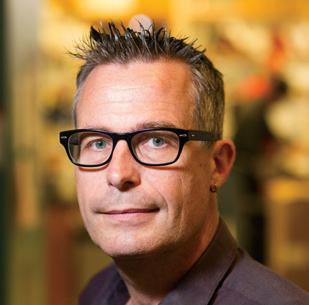
Oriol Sunyer, PhD, received a $982,795 NIH R01 grant for Primordially Conserved Principles Governing Mucosal Immune Responses to Pathogens and Microbiota. The grant spans from March 4, 2019 to December 31, 2022. He also received a $275,000 NIH grant for Unearthing Phagocytic IgM+ Plasma Cells and Their Previously Unrecognized Roles in Innate and Adaptive Immunity. The grant spans from December 1, 2018 to November 30, 2020.
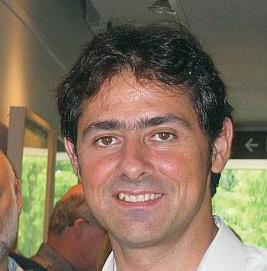

Penn Vet and the Pennsylvania Game Commission have launched the Pennsylvania Wildlife Futures Program to improve disease surveillance and safeguard wildlife and public health.
Led by ecologist Dr. Julie Ellis and veterinarian and toxicologist Dr. Lisa Murphy, the New Bolton Center — based program was established under a five-year, $10 million contract financed by the Game Commission.
With 12 employees, the initiative will increase disease surveillance, management, and research in the Commonwealth.
Andrew Vaughan, PhD, received a $200,000 grant from the Margaret Q. Landenberger Research Foundation for Angiogenesis and Vasculogenesis in Lung Regeneration After Influenza. The grant spans from December 31, 2018 to December 31, 2020.

Charles Vite, PhD, received a $111,506 grant from Biomarin Pharmaceutical for Biomarker Development in Canine MPSIIIA. The grant spans from January 14, 2019 to January 13, 2022. He also received a $2,336,040 NIH Referral CTR grant for Animal Models of Human Genetic Disease. The grant spans from January 18, 2019 to December 31, 2023. He also received a $490,000 NIH P40 grant (direct costs per year) for the National Referral Center for Animal Models of Human Genetic Disease (RCAM), which consists of breeding colonies of more than forty models of human genetic diseases, including many with CNS diseases such as dogs with globoid cell leukodystrophy and mucopolysaccharidoses, and cats with Niemann-Pick disease type C1 and alpha-mannosidosis. The grant spans from January 1, 2018 to September 30, 2023. His collaborators are John Wolfe, VMD, PhD, Margret Casal, DVM, PhD, and Paula Henthorn, PhD. He also received a $75,000 grant from the University of Notre Dame, through its Ara Parseghian Medical Research Fund and Michael, Marcia and Christa Parseghian Endowment for Excellence in Niemann-Pick Type C, for Improving Extracerebellar Npc1 Disease Using Intravenous 2-HydroxypropylbetaCyclodextrin.
Susan Volk, VMD, PhD, received a $150,648 grant from the AKC Canine Health Foundation for Tumor-Permissive Collagen Signatures in Canine Mammary Gland Tumors: Development of Prognostic Markers and Targeted Therapies for Improved Outcomes. The grant spans from March 1, 2018 to February 29, 2020.
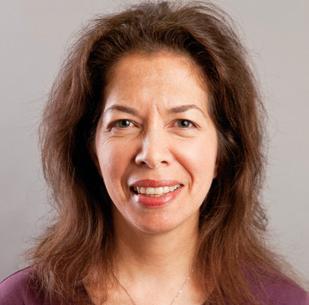
Daljit Vudathala, PhD, received a $10,940 grant from the Commonwealth of Pennsylvania for Influence of Hemolysis on Nutritional Mineral Analysis of Bovine and Equine Serum. The grant spans from January 1, 2019 to September 30, 2019. She also received a $34,700 grant from Pennsylvania Department of Agriculture for Histopathology and Analysis of Anatoxin-a Using LCMS in Channel Catfish. The grant spanned from January 1, 2018 to June 30, 2019. She also received a $9,250 grant from the Pennsylvania Department of Agriculture for Method Development for Bromethalin Analysis in Biological Samples. The grant spanned from January 1, 2018 to June 30, 2019. And she received a $8,510 grant from the Pennsylvania Department of Agriculture for Method Development for Trace Analysis of Avermectins and Related Animal Drugs in Compost. The grant spanned from January 1, 2018 to June 30, 2019. Vudathala is affiliated with Lisa Murphy’s lab.

Brittany Watson, VMD, PhD, received a $1,144,675 grant from the WaterShed Animal Fund to implement a comprehensive veterinary shelter medicine initiative. The intended impact of this program is to inspire and support careers in shelter medicine, facilitate connections between veterinarians and shelters, and promote community collaboration. Penn Vet Shelter Medicine Program will engage with peer institutions and other animal welfare organizations, leveraging scientific and social support to advance to the field.
John Wolfe, VMD, PhD, received a $1,004,205 NIH/NS grant for Translational Studies on Cerebrospinal Fluid (CSF)Directed Gene Therapy for Global Neurometabolic Brain. The grant spans from April 1, 2019 to March 31, 2024.
We cherish those who choose to give annually to Penn Vet in a generous way. Our community grows stronger each time you give, fueling The Power of Penn Vet. In honor of you, our loyal donors, we bestow this recognition based on your years of giving:
Jeffrey Carey, V’19, received the Saul Winegrad Award for Outstanding Dissertation from Penn Biomedical Graduate Studies. The award recognizes a dissertation of outstanding quality that makes a significant contribution to biomedical science. Carey is affiliated with Mark Goulian.
Mariel Covo, V’20, was awarded the 2019 Boehringer Ingelheim Veterinary Research Scholar Award for her work studying the use of CAR-T cells against B cell lymphoma.
Aga Galej, V’21, co-organized Penn’s participation in a nine-day leadership camp for high school students hosted by the National Student Leadership Conference (NSLC). The event, held at more than a dozen universities in the US and abroad, offers students a chance to explore careers ranging from medicine, marine biology, and engineering, to acting and law. This year a veterinary medicine program was offered at Penn for the first time; some 175 students took part in labs, lectures, field trips, and leadership development.
1884 GOLD CIRCLE
Our donors who’ve given for 5 or more years.
1884 SILVER CIRCLE
Our donors who’ve given for 3 or more years.
Stefan Gallini, V’20, completed a one-month externship in Thailand in Spring 2019, working with Asian elephants as part of a multiinstitutional, international team evaluating clinical diagnostics in this species. While there he pursued his own primary investigation of plasma cardiac troponin concentrations in elephants, a study funded by a competitive grant awarded by the Zebra Foundation for Veterinary Zoological Education. As part of the clinical research team, Gallini assisted with sample collection, processing, and analysis and managed a mobile clinical pathology laboratory in the field. The work, soon to be published in peer-reviewed journals, will contribute to on-site veterinary care of Asian elephants and possibly to the early detection of disease caused by elephant endotheliotropic herpesvirus virus, which threatens the sustainability of captive elephants worldwide. Gallini is affiliated with the Chulalongkorn University Department of Veterinary Medicine and Mahidol University Faculty of Veterinary Science in Thailand. His collaborators are Peter DiGeronimo, VMD; João Brandão, LMV, MS, Dipl. ECZM (Avian); and Erica Ward, DVM.
PENN
We extend a warm welcome to our newest members who made their first gift to Penn Vet this year.
The 1884 Circle of Friends recognition connects our most loyal and steadfast donors with Penn Vet’s enduring service, since 1884, to the community and the world.
Please contact Barbara Belt (610) 925-6500
beltb@vet.upenn.edu
Emily Griswold, V’20, took home first-place honors during the 2019 Student American Veterinary Medical Association (SAVMA) Bovine Palpation Competition, held March 9–11, 2019 at the University of Georgia in Athens, Georgia. Griswold, Jordan Fairman, V’20, Amy Middleton, V’21, Michael Topper, V’21, and Karalyn Lonngren, V’21, made up the first Penn Vet representation to ever compete in the national contest. The five-student-team was one of thirteen teams representing veterinary schools across the United States. Penn Vet’s team has been practicing monthly at Marshak Dairy with Michael Pesato, DVM to improve their skills and knowledge of bovine reproduction.
Souci Louis, V’20, was awarded the 2019 Dr. Jack Walther Leadership Award by the Western Veterinary Conference. Colleen Moore, V’20, was awarded the Richard W. Newpher/ Pennsylvania Farm Bureau Scholarship. The scholarship supports students pursuing careers in food animal medicine.
CLASS OF 2023 BY THE NUMBERS 122 STUDENTS
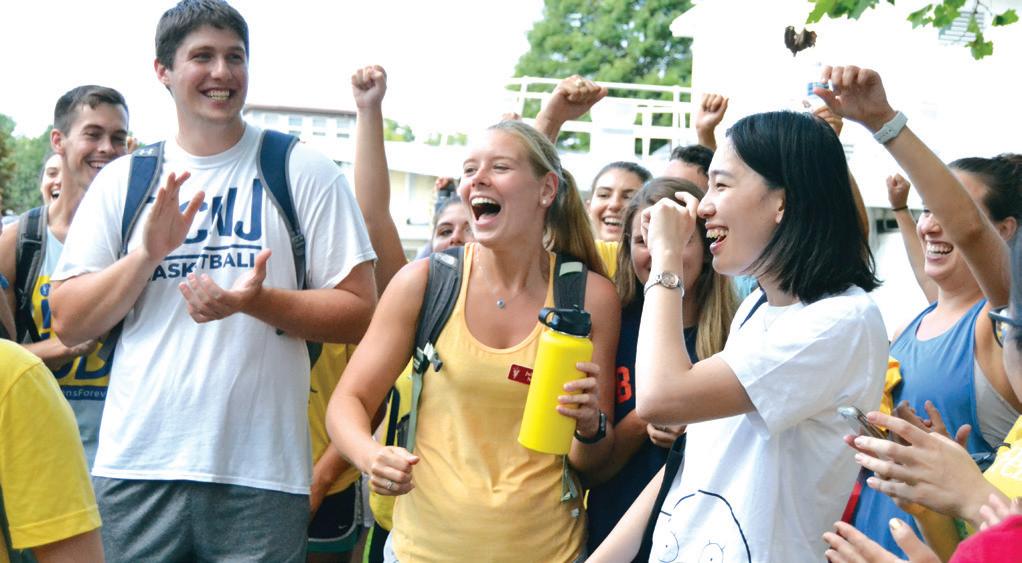
83 STUDENTS Mid-Atlantic, includes Pennsylvania

14 STUDENTS New England
8 STUDENTS South
4 STUDENTS International
4 STUDENTS Midwest
4 STUDENTS Puerto Rico
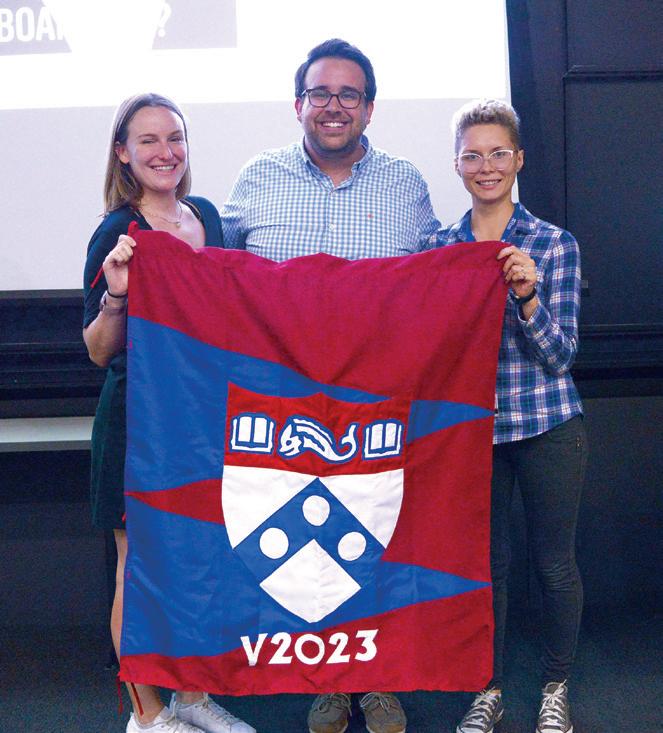
50 Pennsylvania residents 21 Pennsylvania counties represented (dark blue)
3 STUDENTS Pacific
2 STUDENTS Mountain
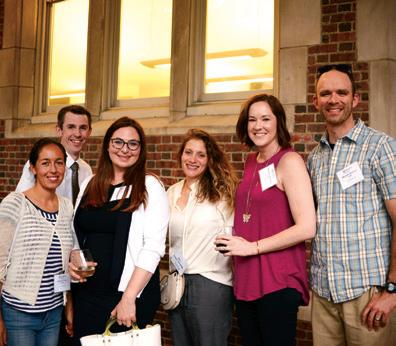



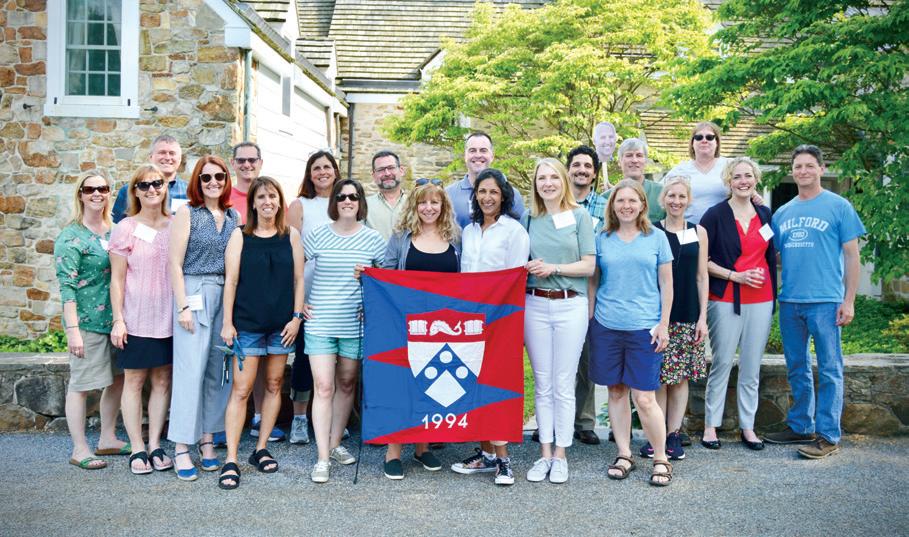
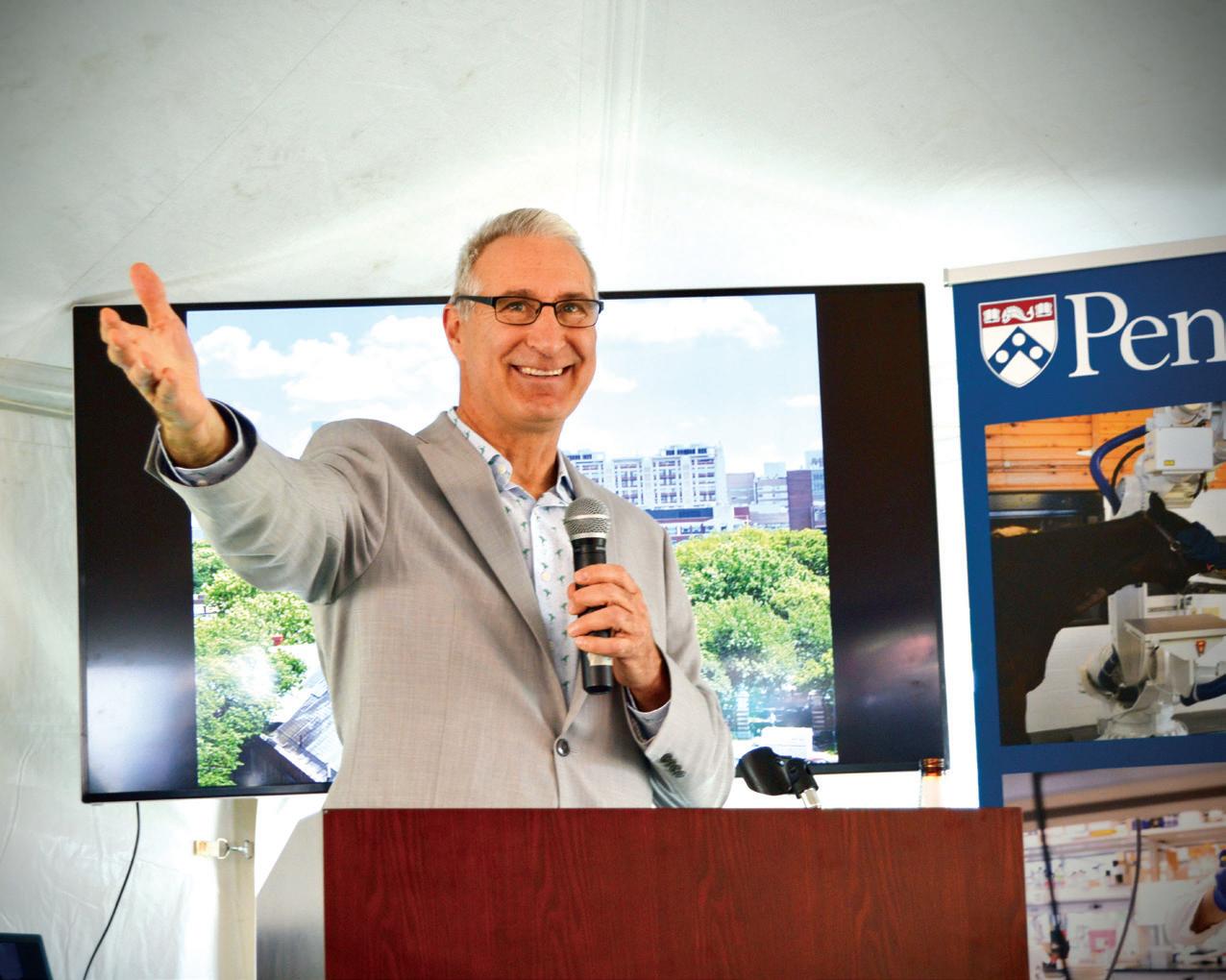

Robert Reese, Sr., V’59, was honored for his 60 years of veterinary service at an open house celebration on June 12 at Pine Creek Veterinary Associates in Lock Haven, Pennsylvania. Reese also works part-time at the Clinton County SPCA treating and vaccinating stray animals.
Norman Altman, V’63 earned three honors from the University of Miami, including induction into the Iron Arrow Honor Society, the Faculty Senate Outstanding Service Award, and the School of Medicine’s Sylvester Comprehensive Cancer Center Lifetime Achievement Award. Altman has been a professor at the University of Miami since 1974, and currently serves as the director of the Division of Comparative Pathology and the ombudsperson for the Miller School of Medicine. He is the only veterinarian to be a director of an NIH-funded comprehensive cancer center.
Linda Rhodes, V’78, received the Iron Paw Award from the Kansas City Animal Health Corridor in August. The award is given annually to an individual from research, academia, industry, or government who has made a significant impact on or contribution to global animal health.
James F. Dougherty, V’80, was honored as a Loyal Son of Rutgers, the highest service award given by the Rutgers Alumni Association, on April 13. Dougherty was also elected to serve as chair of the Rutgers University Board of Trustees, beginning on July 1, having been vice chair for the past two years.
Kenneth D. Dazen, V’86, successfully maintained his certification as a Diplomate of the American Board of Veterinary Practitioners (ABVP), one of only 135 Diplomates specializing in avian practice. Dazen became a Diplomate in 2000; avian practice is unique among veterinary specialties in that certification expires every ten years.
Michele Rosenbaum, V’89, was recently promoted to medical lead in dermatology as part of Veterinary Specialty Operations at Zoetis (formerly Pfizer Animal Health), where she has worked since 2006. She was also awarded the company’s 2018 President’s Circle Award for excellence. In March, Rosenbaum presented six hours of dermatology topics at the Indiana Veterinary Medical Association.
Lindsay Shreiber, V’91, opened the Valley Veterinary Hospital in Phoenixville, Pennsylvania, in May. Located in the former Bull Tavern, the new facility offers expanded veterinary services, boarding, daycare, and grooming.
Karen Todd-Jenkins, V’92, joined Shepherd, a Jacksonville, Florida–based advertising agency. Todd-Jenkins will serve as technical director on the Boehringer Ingelheim Animal Health USA Inc. account across its entire brand portfolio.
Karen Froberg-Fejko, V’96, and co-owner Tim Fisher, of the Foster Corporation, were honored in May by the US Small Business Administration (SBA) as New Jersey’s 2019 Small Business Persons of the Year. The award is part of the celebration of National Small Business Week, when the SBA recognizes the achievements of small business owners across the country. The Foster Corporation is the parent of two other small businesses, Bio-Serv and Radon Supplies. Froberg-Fejko is also board chair of the New Jersey Association for Biomedical Research.
Liz Bales, V’00, was on the June 24 broadcast of NPR’s How I Built This, hosted by Guy Raz. Bales spoke about her role as the product developer for her feline indoor hunting feeder system, and the launch of her company Doc & Phoebe’s Cat Company at the Sixers Innovation Lab in Camden, New Jersey, a start-up accelerator that supports early-stage companies in the sports and consumer products sector.
Tripp Stewart, V’00, was honored as the 2019 Distinguished Virginia Veterinarian by the Virginia Veterinary Medical Association for bringing positive recognition to veterinary medicine in the state. Stewart founded Charlottesville’s Greenbrier Emergency Animal Hospital, the only afterhours and emergency veterinary office in the area that treats walk-in patients. Stewart has been president of the Jefferson Area Veterinary Medicine Association for the past three years.
Rachel Toaff-Rosenstein, V’09, welcomed a baby girl, Carmi Shalva, sister to Matan, Gefen, Naveh, and Segev, on July 8. ToaffRosenstein became a Diplomate of the American College of Animal Welfare and has been working as a research scientist at the Antelliq Innovation Center (now owned by Merck) developing automated animal health monitoring technology.
Michael Sheruda, V’12, and Maral Avetian, V’12, welcomed their second child, Michael Sheruda, Jr., on February 6. Big sister Amelia is thrilled, as are Michael and Maral.
Bill Ciancarelli, V’19, CPT United States Army, Veterinary Corps, finished the second phase of his Officer Basic Course as executive officer/class leader with distinction, winning the 94th Brigadier General Charles Elia Award.
Bernard Francis Brennan, V’46, of Hobe Sound, Florida, passed away on April 26, at age 97. A graduate of the University of South Dakota and Penn Vet, he began his veterinary practice in Aiken, South Carolina. In 1953, he moved to Westbury, New York, where he established an equine practice at Roosevelt Raceway and opened a surgical hospital. Brennan was an active member of the American Association of Equine Practitioners from its founding and served as the organization’s president in 1979. He held leadership positions in the New York and New Jersey State Veterinary Associations.
Ellsworth E. Barber, V’50, passed away on July 4. He served as an officer in the Navy during World War II. Barber was a veterinarian in Mansfield, Pennsylvania.
Hummel C. Fager, V’53, passed away on April 16. He served as quartermaster on the USS Vicksburg in the Pacific theater in World War II. He and his brother, Charles B. Fager IV, owned the Camp Hill Animal Hospital for 50 years. Fager also provided spay and neuter services to Molly’s Place Rescue and Adoption Center, an animal rescue in Mechanicsburg, Pennsylvania, for 15 years. He was a member of the Capital City Veterinary Medical Association and the American Veterinary Medical Association.
William M. Adams, V’54, passed away on June 17. He was a faculty member at Western College of Veterinary Medicine from 1970 to 1980. A charter member of the American College of Theriogenologists, he served as the organization’s president from 1975 to 1976. He was also an honor roll member of the Society of Theriogenology.
Warren N. Davis, V’55, passed away on July 4. A graduate of Lake Consolidated School, he earned his bachelor’s degree in animal husbandry from Penn State University. He served as a captain in the US Air Force Medical Service Corps. He was a veterinarian in Lake Ariel, Pennsylvania, for 53 years.
Bernard Levine, V’55, passed away on March 9. Levine founded the Toms River (New Jersey) Animal Hospital, treating family pets as well as the cows, horses, sheep, and chickens on Ocean County’s many farms. Levine was a pioneer of the surgical treatment of heartworm disease in dogs. He served as president of the American Heartworm Society and lectured internationally about the disease. He continued to work part-time at the veterinary hospital into his mid-80s, alongside his son, Richard Levine, V’81

Vernon Yingling, V’57, passed away on May 1. He worked at veterinary clinics in Bellefonte and Pittsburgh, Pennsylvania, before founding the Mount Nittany Veterinary Hospital in State College, providing medical care for farm and domestic animals throughout Centre County for more than 25 years. Yingling was a past president of the Pennsylvania Veterinary Medical Association and a member of the State Board of Veterinary Medicine.
Leigh Marsh, V’59, passed away on May 31. He attended Penn State University, earning both his BS and MS in Animal Industry. He served in the Air Force as a lieutenant during the Korean War. Fondly known as “Doc,” he worked at a successful veterinary practice in North Philadelphia for 55 years.
Edward “Doc” Mersky, V’61, passed away on March 25. An all-star athlete in baseball and basketball, he was drafted out of high school by the Brooklyn Dodgers and played for their farm team in Vero Beach, Florida. Mersky was drafted into the US Marine Corps and served for two years as an MP at Guantanamo Bay, Cuba, during the Korean War. Following an honorable discharge, he returned to school and received his veterinary degree from Penn. Mersky opened his solo veterinary practice in 1961, treating both large and small animals. He eventually transitioned to caring exclusively for horses, and he retired from equine veterinary medicine after 47 years of practice.
Andrew Currie, V’63, passed away on May 3. Upon graduation from Penn Vet, he moved to Houston to pursue his specialty in equine lameness and medicine, then relocated to Lexington, Kentucky, the following year to work with D. L. Proctor, one of the pioneers in equine orthopedic surgery. Currie subsequently returned to Houston to open an equine clinic. He served on the Board of Directors of the American Association of Equine Practitioners and the Texas Horse Racing Association, was chairman of the Equine Committee for the Texas Veterinary Medical Association, and was a member of numerous professional organizations. He was a lifetime committeeman of the Houston Livestock Show and Rodeo.
Fred Fernich, V’63, passed away in May. Fernich held a BS in economics from Cornell University. He practiced at the Brentwood-Islip (New York) Hospital for Animals and received Penn Vet’s Alumni Award of Merit in 1998. Fernich was the father of the late Gwen Lowitt, V’94 Gwen’s husband, Gary Lowitt, along with Dr. and Mrs. Fernich, established the Gwen Fernich Lowitt, V’94, Memorial Endowed Opportunity Scholarship at Penn Vet.
Alan Klide, V’65, passed away on September 12. He received his undergraduate degree from the University of Georgia. Klide spent his entire, distinguished career at Penn Vet. He was appointed Assistant Professor of Anesthesiology in 1969, promoted to Associate Professor in 1972, and then to Professor in 1994. Klide served as Section Chief and Director of Small Animal Anesthesia, and became Emeritus Professor of Anesthesia before retiring in 2007. He was a Charter Member of the American College of Veterinary Anesthesia and Analgesia, and a member of the International Veterinary Acupuncture Society. Klide will be remembered as a true pioneer in veterinary anesthesia, and for his dedication to the field.
Charles L. “Lee” Barnes, Jr., V’66, passed away on June 9. Barnes was the owner and operator of the North Sewickley (Pennsylvania) Veterinarian Clinic and worked for 32 years as the supervisory veterinary medical officer for the United States Department of Agriculture.
Ross Lee Frazer, V’69, MD, passed away on January 24. He began practicing veterinary medicine in 1969 and established his own practice, Frazer Veterinary Clinic, in Homer City, Pennsylvania, in 1971. Frazer returned to school at age 36 to pursue his medical degree. In 1986, he renamed his practice to include both veterinary and family medicine. He was a Fellow of the American Academy of Family Physicians and a Diplomate of the American Board of Family Practice. Frazer practiced medicine a few months shy of 50 years as a veterinarian and 32 years as a family practitioner.
John Sellers, V’75, passed away on July 16. He was a lieutenant junior grade in the US Navy Reserve and a veteran of the Vietnam War. Sellers established a large animal veterinary practice in Goodville, Pennsylvania. He was an active member of the Berks Peace Community, founded a local Zen Buddhist meditation group, and cohosted BCTV programs Alternative News and Different Views and Centering on Peace He was also an associate chaplain at Albright College, a volunteer Buddhist mentor for the Berks County Jail System, and a board member of the Berks Counseling Center.
Richard A. Fondrk, V’82, passed away on February 8. He attended Penn State University. Fondrk was a self-employed large animal veterinarian. He was also active in the Irwin Men’s Summer Basketball League as a player, manager, and scorekeeper.
Kathleen Moody, V’82, passed away on January 11. She completed residency training in laboratory animal and comparative medicine at Penn State Health Milton S. Hershey Medical Center, and then interned at Detwiler Animal Hospital in Reading, Pennsylvania. She was a clinical professor in the Section of Comparative Medicine at Yale University School of Medicine from 1986 to 2001. During her career she served as consultant and interim clinician for Bayer Corporation in West Haven, Connecticut; Boehringer Ingelheim Pharmaceuticals in Ridgefield, Connecticut; and 15 other biomedical research organizations. In 2005, she began studying for the chaplaincy at Hartford Seminary, graduating with an MA in transformative leadership and spirituality in 2018.
Penn Vet graduates achieve remarkable successes every day. Whether you have a new address, are moving forward in your career, announcing an addition to the family or honoring the life of a fellow alumnus, Alumni Relations wants to hear about it. Please share your news! Visit the Alumni page of the Penn Vet website, email your news to the alumni office at grovessh@vet.upenn.edu, or write to us at Alumni Relations, Penn Vet Alumni Office, 3800 Spruce Street, Suite 172E, Philadelphia, PA 19104. We may edit submissions due to space considerations.
EDITORIAL
Editor Martin J. Hackett
Contributing Editor
Sacha Adorno
Writers at Large
Katherine Unger Baillie, Gina Vitale
Contributing Writer
Sacha Adorno
Class Notes Editor
Shannon Groves
DESIGN
Designer
Anne Marie Kane, Imogen Design
Photographers at Large
John Donges, Hannah Kleckner Hall, Eric Sucar
Contributing Photographers
Paul Ching, David C. Hill
Visual Contributor
Hannah Kleckner Hall
Gilbert S Kahn Dean of Veterinary Medicine
Dr. Andrew M. Hoffman
Vice Dean of Institutional Advancement
Meaghan R. Hogan, JD, LLM
Director of Communications and Marketing
Martin J. Hackett
Director of Annual Giving
Mary Berger
Director of Alumni Relations
Shannon Groves
Director of Development, Companion Animals
Helen Radenkovic
Director of Development, New Bolton Center
Margaret Leardi
CHANGE OF ADDRESS
Sarah Trout
University of Pennsylvania School of Veterinary Medicine 3800 Spruce Street Philadelphia, PA 19104-6010 215-746-7460 strout@vet.upenn.edu
None of these articles is to be reproduced in any form without the permission of the School.
© Copyright 2019 by the Trustees of the University of Pennsylvania. The University of Pennsylvania values diversity and seeks talented students, faculty, and staff from diverse backgrounds. The University of Pennsylvania does not discriminate on the basis of race, sex, sexual orientation, gender identity, religion, color, national or ethnic origin, age, disability, or status as a Vietnam Era Veteran or disabled veteran in the administration of educational policies, programs or activities; admissions policies; scholarship and loan awards; athletic, or other University administered programs or employment. Questions or complaints regarding this policy should be directed to: Executive Director, Office of Affirmative Action and Equal Opportunity Programs, Sansom Place East, 3600 Chestnut Street, Suite 228, Philadelphia, PA 19104-6106 or by phone at 215-898-6993 (Voice) or 215-898-7803 (TDD).
A beloved member of his family, 13-year-old Patches came to New Bolton Center needing Emergency and Critical Care to diagnose and treat his unusual case: Patches was full of metal! “He had a stomach full of junk,” smiled his devoted owner, Lisa Pattisall. New Bolton Center’s small ruminant clinicians surgically removed enough metal to fill a football — including a bracelet his family recognized as lost from years ago.

3800 Spruce Street
Philadelphia, PA 19104-6008
United Way of Greater Phila. & So. NJ: #50178
NOVEMBER 1
V’21 White Coat Ceremony
5:30 PM
Philadelphia, PA
NOVEMBER 5
First Tuesday Lecture
Robotic Imaging: Pioneering the Future
6:30 PM
Kennett Square, PA
NOVEMBER 8
Student American Veterinary Medical Association Auction
Philadelphia, PA
DECEMBER 3
First Tuesday Lecture
Equine Neurologic Diseases
6:30 PM
Kennett Square, PA
DECEMBER 9
Alumni Reception at the AAEP Convention
6:00–8:00 PM


Denver, CO
JANUARY 2020
NEW!
JANUARY 2
Registration Opens for Summer Term 2020
Online Graduate Certificate in Animal Welfare and Behavior
JANUARY 4–12
Farm Show
Harrisburg, PA
JANUARY 19
Alumni Reception at the NAVC VMX Convention
7:00–9:00 PM
Hyatt Regency
Orlando, FL
MARCH 3
First Tuesday Lecture
Aging Gracefully: Caring for Your Geriatric Horse
6:30 PM
Kennett Square, PA
APRIL 2020
APRIL 7
First Tuesday Lecture
Laminitis Management: From Research Lab to the Barn
6:30 PM
Kennett Square, PA
MAY 2020
MAY 5
First Tuesday Lecture
Emergency and Critical Care for the Colic Patient
6:30 PM
Kennett Square, PA
MAY 15–16
Alumni Weekend & Reunion
Philadelphia and New Bolton Center
MAY 18
V’20 Commencement
Philadelphia, PA
JUNE 2020
NEW!
JUNE 1–4
Leading Veterinary Entrepreneurship
A veterinary education program in partnership with the Wharton School
Philadelphia, PA
JUNE 2
First Tuesday Lecture Innovations and Safety in Cardiology
6:30 PM
Kennett Square, PA
Penn Vet is proud to print Bellwether magazine on FSC® (Forest Stewardship Council™) certified paper, which supports the growth of responsible forest management worldwide through its international standards.